Pioneer VSX-1020 User Manual

AUDIO/VIDEO MULTI-CHANNEL RECEIVER
RECEPTOR MULTICANAL DE AUDIO/VÍDEO
VSX-1020
Register your product on
http://www.pioneerelectronics.com (US) http://www.pioneerelectronics.ca (Canada)
· Protect your new investment
The details of your purchase will be on file for reference in the event of an insurance claim such as loss or theft.
·Receive free tips, updates and service bulletins on your new product
·Improve product development
Your input helps us continue to design products that meet your needs.
· Receive a free Pioneer newsletter
Registered customers can opt in to receive a monthly newsletter.
Operating Instructions Manual de instrucciones

WARNING
This equipment is not waterproof. To prevent a fire or shock hazard, do not place any container filled with liquid near this equipment (such as a vase or flower pot) or expose it to dripping, splashing, rain or moisture.
D3-4-2-1-3_A1_En
WARNING
Before plugging in for the first time, read the following section carefully.
The voltage of the available power supply differs according to country or region. Be sure that the power supply voltage of the area where this unit will be used meets the required voltage (e.g., 230 V or 120 V) written on the rear panel.
D3-4-2-1-4*_A1_En
This product is for general household purposes. Any failure due to use for other than household purposes (such as long-term use for business purposes in a restaurant or use in a car or ship) and which requires repair will be charged for even during the warranty period.
K041_A1_En
IMPORTANT NOTICE
THE MODEL NUMBER AND SERIAL NUMBER OF THIS EQUIPMENT ARE ON THE REAR OR BOTTOM. RECORD THESE NUMBERS ON YOUR ENCLOSED WARRANTY CARD AND KEEP IN A SAFE PLACE FOR FUTURE REFERENCE.
D36-AP9-1_A1_En
This Class B digital apparatus complies with Canadian ICES-003.
D8-10-1-3_A1_En
If the AC plug of this unit does not match the AC outlet you want to use, the plug must be removed and appropriate one fitted. Replacement and mounting of an AC plug on the power supply cord of this unit should be performed only by qualified service personnel. If connected to an AC outlet, the cut-off plug can cause severe electrical shock. Make sure it is properly disposed of after removal.
The equipment should be disconnected by removing the mains plug from the wall socket when left unused for a long period of time (for example, when on vacation).
D3-4-2-2-1a_A1_En
WARNING: Handling the cord on this product or cords associated with accessories sold with the product may expose you to chemicals listed on proposition 65 known to the State of California and other governmental entities to cause cancer and birth defect or other reproductive harm.
Wash hands after handling.
D36-P5_B1_En
CAUTION
This product satisfies FCC regulations when shielded cables and connectors are used to connect the unit to other equipment. To prevent electromagnetic interference with electric appliances such as radios and televisions, use shielded cables and connectors for connections.
D8-10-3a_A1_En
Information to User
Alterations or modifications carried out without appropriate authorization may invalidate the user’s right to operate the equipment.
D8-10-2_A1_En
NOTE:
This equipment has been tested and found to comply with the limits for a Class B digital device, pursuant to Part 15 of the FCC Rules. These limits are designed to provide reasonable protection against harmful interference in a residential installation. This equipment generates, uses, and can radiate radio frequency energy and, if not installed and used in accordance with the instructions, may cause harmful interference to radio communications. However, there is no guarantee that interference will not occur in a particular installation. If this equipment does cause harmful interference to radio or television reception, which can be determined by turning the equipment off and on, the user is encouraged to try to correct the interference by one or more of the following measures:
—Reorient or relocate the receiving antenna.
—Increase the separation between the equipment and receiver.
—Connect the equipment into an outlet on a circuit different from that to which the receiver is connected.
—Consult the dealer or an experienced radio/TV technician for help.
D8-10-1-2_A1_En
FEDERAL COMMUNICATIONS COMMISSION DECLARATION OF CONFORMITY
This device complies with part 15 of the FCC Rules. Operation is subject to the following two conditions: (1) This device may not cause harmful interference, and (2) this device must accept any interference received, including interference that may cause undesired operation.
Product Name: AUDIO/VIDEO MULTI-CHANNEL RECEIVER Model Number: VSX-1020
Responsible Party Name: PIONEER ELECTRONICS (USA) INC. SERVICE SUPPORT DIVISION
Address: 1925 E. DOMINGUEZ ST. LONG BEACH, CA 90810-1003, U.S.A. Phone: 1-800-421-1404
URL: http://www.pioneerelectronics.com
D8-10-4*_C1_En

IMPORTANT
CAUTION
RISK OF ELECTRIC SHOCK
DO NOT OPEN
The lightning flash with arrowhead symbol, within an equilateral triangle, is intended to alert the user to the presence of uninsulated “dangerous voltage” within the product’s enclosure that may be of sufficient magnitude to constitute a risk of electric shock to persons.
CAUTION:
TO PREVENT THE RISK OF ELECTRIC SHOCK, DO NOT REMOVE COVER (OR BACK). NO USER-SERVICEABLE PARTS INSIDE. REFER SERVICING TO QUALIFIED SERVICE PERSONNEL.
The exclamation point within an equilateral triangle is intended to alert the user to the presence of important operating and maintenance (servicing) instructions in the literature accompanying the appliance.
D3-4-2-1-1_A1_En
1)Read these instructions.
2)Keep these instructions.
3)Heed all warnings.
4)Follow all instructions.
5)Do not use this apparatus near water.
6)Clean only with dry cloth.
7)Do not block any ventilation openings. Install in accordance with the manufacturer’s instructions.
8)Do not install near any heat sources such as radiators, heat registers, stoves, or other apparatus (including amplifiers) that produce heat.
9)Do not defeat the safety purpose of the polarized or grounding-type plug. A polarized plug has two blades with one wider than the other. A grounding type plug has two blades and a third grounding prong. The wide blade or the third prong are provided for your safety. If the provided plug does not fit into your outlet, consult an electrician for replacement of the obsolete outlet.
10)Protect the power cord from being walked on or pinched particularly at plugs, convenience receptacles, and the point where they exit from the apparatus.
11)Only use attachments/accessories specified by the manufacturer.
12)Use only with the cart, stand, tripod, bracket, or table specified by the manufacturer, or sold with the apparatus. When a cart is used, use caution when moving the cart/apparatus combination to avoid injury from tip-over.
13)Unplug this apparatus during lightning storms or when unused for long periods of time.
14)Refer all servicing to qualified service personnel. Servicing is required when the apparatus has been damaged in any way, such as power-supply cord or plug is damaged, liquid has been spilled or objects have fallen into the apparatus, the apparatus has been exposed to rain or moisture, does not operate normally, or has been dropped.
D3-7-13-69_En
VENTILATION CAUTION
When installing this unit, make sure to leave space around the unit for ventilation to improve heat radiation (at least 40 cm at top, 10 cm at rear, and 20 cm at each side).
WARNING
Slots and openings in the cabinet are provided for ventilation to ensure reliable operation of the product, and to protect it from overheating. To prevent fire hazard, the openings should never be blocked or covered with items (such as newspapers, table-cloths, curtains) or by operating the equipment on thick carpet or a bed.
D3-4-2-1-7b*_A1_En
Operating Environment
Operating environment temperature and humidity: +5 °C to +35 °C (+41 °F to +95 °F); less than 85 %RH (cooling vents not blocked)
Do not install this unit in a poorly ventilated area, or in locations exposed to high humidity or direct sunlight (or strong artificial light)
WARNING
To prevent a fire hazard, do not place any naked flame sources (such as a lighted candle) on the equipment.
D3-4-2-1-7a_A1_En
CAUTION
The STANDBY/ON switch on this unit will not completely shut off all power from the AC outlet. Since the power cord serves as the main disconnect device for the unit, you will need to unplug it from the AC outlet to shut down all power. Therefore, make sure the unit has been installed so that the power cord can be easily unplugged from the AC outlet in case of an accident. To avoid fire hazard, the power cord should also be unplugged from the AC outlet when left unused for a long period of time (for example, when on vacation).
Caution
To prevent fire hazard, the Class 2 Wiring Cable should be used for connection with speaker, and should be routed away from hazards to avoid damage to the insulation of the cable.

Thank you for buying this Pioneer product. Please read through these operating instructions so you will know how to operate your model properly. After you have finished reading the instructions, put them away in a safe place for future reference.
Contents
Flow of settings on the receiver . . .7
01 Before you start
Checking what’s in the box. . . . . . . . . . . . . . . . 8 Installing the receiver . . . . . . . . . . . . . . . . . . . . 8
Loading the batteries . . . . . . . . . . . . . . . . . . . . 8
02 Controls and displays
Front panel. . . . . . . . . . . . . . . . . . . . . . . . . . . . 9 Display. . . . . . . . . . . . . . . . . . . . . . . . . . . . . . 10 Remote control . . . . . . . . . . . . . . . . . . . . . . . 12
Operating range of remote control unit. . . . . 13
03 Connecting your equipment
Rear panel . . . . . . . . . . . . . . . . . . . . . . . . . . . 14
Determining the speakers’ application . . . . . . 15 Other speaker connection . . . . . . . . . . . . . . 16
Placing the speakers . . . . . . . . . . . . . . . . . . 17
Some tips for improving sound quality . . . . . 17 Connecting the speakers . . . . . . . . . . . . . . . . 18 Installing your speaker system . . . . . . . . . . . . 19 Bi-amping your speakers . . . . . . . . . . . . . . . 20 Bi-wiring your speakers . . . . . . . . . . . . . . . . 20 Selecting the Speaker system . . . . . . . . . . . . . 21
Front height setup . . . . . . . . . . . . . . . . . . . . 21 Front wide setup . . . . . . . . . . . . . . . . . . . . . 21 Speaker B setup . . . . . . . . . . . . . . . . . . . . . 21 Bi-Amping setup . . . . . . . . . . . . . . . . . . . . . 21 ZONE 2 setup . . . . . . . . . . . . . . . . . . . . . . . 21
About the audio connection . . . . . . . . . . . . . . 22 About the video converter. . . . . . . . . . . . . . . . 22 Connecting your TV and playback
components. . . . . . . . . . . . . . . . . . . . . . . . . . 23
Connecting using HDMI . . . . . . . . . . . . . . . 23 Connecting your DVD player with no HDMI output . . . . . . . . . . . . . . . . . . . . . . . . . . . . . 25
Connecting your TV with no HDMI input . . . 26 Connecting a satellite/cable receiver or
other set-top box . . . . . . . . . . . . . . . . . . . . . . 27
Connecting a HDD/DVD recorder, VCR and other video sources . . . . . . . . . . . . . . . . . . . . 27
Connecting other audio components . . . . . . . 28 About the WMA9 Pro decoder . . . . . . . . . . . 28 Connecting AM/FM antennas . . . . . . . . . . . . . 29 Connecting external antennas . . . . . . . . . . . 29
MULTI-ZONE setup. . . . . . . . . . . . . . . . . . . . . 30
Making MULTI-ZONE connections . . . . . . . . 30 Connecting Optional Bluetooth ADAPTER . . . 31 Connecting a SiriusConnect™ Tuner. . . . . . . . 31 Connecting to the network through LAN interface . . . . . . . . . . . . . . . . . . . . . . . . . . . . 32
Connecting an HDMI-equipped component
to the front panel input . . . . . . . . . . . . . . . . . . 32
Connecting an iPod . . . . . . . . . . . . . . . . . . . . 33
Connecting a USB device . . . . . . . . . . . . . . . . 33 Connecting a USB device for Advanced
MCACC output . . . . . . . . . . . . . . . . . . . . . . . . 34
Connecting an IR receiver. . . . . . . . . . . . . . . . 35 Operating other Pioneer components with
this unit’s sensor . . . . . . . . . . . . . . . . . . . . . . 35
Plugging in the receiver . . . . . . . . . . . . . . . . . 36
04 Basic Setup
Changing the OSD display language
(OSD Language) . . . . . . . . . . . . . . . . . . . . . . . 37
Automatically setting up for surround sound (Auto MCACC) . . . . . . . . . . . . . . . . . . . . . . . . 37
Problems when using the Auto MCACC
Setup. . . . . . . . . . . . . . . . . . . . . . . . . . . . . . 40 The Input Setup menu . . . . . . . . . . . . . . . . . . 40
Input function default and possible
settings . . . . . . . . . . . . . . . . . . . . . . . . . . . . 41
05 Basic playback
Playing a source . . . . . . . . . . . . . . . . . . . . . . . 42
Playing a source with HDMI connection . . . . 43
Playing an iPod . . . . . . . . . . . . . . . . . . . . . . . 43
Playing back files stored on an iPod . . . . . . . 43
Playing a USB device . . . . . . . . . . . . . . . . . . . 45
Playing back audio files stored on a USB memory device. . . . . . . . . . . . . . . . . . . . . . . 45
Playing back photo files stored on a USB memory device. . . . . . . . . . . . . . . . . . . . . . . 46
About playable file formats . . . . . . . . . . . . . . 47
Listening to the radio . . . . . . . . . . . . . . . . . . . 48 Improving FM sound . . . . . . . . . . . . . . . . . . 48
Using Neural Surround . . . . . . . . . . . . . . . . 48 Tuning directly to a station . . . . . . . . . . . . . . 48 Saving station presets . . . . . . . . . . . . . . . . . 48 Naming station presets . . . . . . . . . . . . . . . . 49 Listening to station presets. . . . . . . . . . . . . . 49
Bluetooth® ADAPTER for Wireless
Enjoyment of Music . . . . . . . . . . . . . . . . . . . . 50 Wireless music play . . . . . . . . . . . . . . . . . . . 50
Pairing Bluetooth ADAPTER and Bluetooth wireless technology device . . . . . . . . . . . . . . 50 Listening to Music Contents of Bluetooth wireless technology device with Your
System . . . . . . . . . . . . . . . . . . . . . . . . . . . . 51
Listening to Internet radio stations . . . . . . . . . 52 Programming the Internet radio stations . . . 52 Listening to Satellite Radio . . . . . . . . . . . . . . . 53 Listening to SIRIUS Radio . . . . . . . . . . . . . . 54

Saving channel presets . . . . . . . . . . . . . . . . 55 Using the SIRIUS Menu . . . . . . . . . . . . . . . . 55
06 Listening to your system
Auto playback . . . . . . . . . . . . . . . . . . . . . . . . 56
Listening in surround sound. . . . . . . . . . . . . . 56 Standard surround sound . . . . . . . . . . . . . . 56 Using the Advanced surround effects. . . . . . 58
Listening in stereo . . . . . . . . . . . . . . . . . . . . . 58
Using Front Stage Surround Advance . . . . . . . 59
Using Stream Direct. . . . . . . . . . . . . . . . . . . . 59
Selecting MCACC presets. . . . . . . . . . . . . . . . 60 Choosing the input signal. . . . . . . . . . . . . . . . 60 Better sound using Phase Control . . . . . . . . . 61
07 Control with HDMI function
Making Control with HDMI connections . . . . . 62
HDMI Setup . . . . . . . . . . . . . . . . . . . . . . . . . . 63
Before using synchronization . . . . . . . . . . . . . 64 About synchronized operations. . . . . . . . . . . . 64
About connections with a product of
a different brand that supports the Control with HDMI function . . . . . . . . . . . . . . . . . . . 65
Setting the PQLS function . . . . . . . . . . . . . . . 65 Cautions on the Control with HDMI
function . . . . . . . . . . . . . . . . . . . . . . . . . . . . . 66
08 Using other functions
Setting the Audio options . . . . . . . . . . . . . . . . 67 Setting the Video options . . . . . . . . . . . . . . . . 70 Switching the speaker terminal . . . . . . . . . . . 72 Using the MULTI-ZONE controls . . . . . . . . . . . 72 Making an audio or a video recording . . . . . . . 73 Reducing the level of an analog signal . . . . . . 74
Using the sleep timer . . . . . . . . . . . . . . . . . . . 74 Dimming the display . . . . . . . . . . . . . . . . . . . 74
Checking your system settings . . . . . . . . . . . . 74
Resetting the system . . . . . . . . . . . . . . . . . . . 75
Default system settings . . . . . . . . . . . . . . . . 75
09 Controlling the rest of your system
Operating multiple receivers. . . . . . . . . . . . . . 76 Setting the remote to control other
components. . . . . . . . . . . . . . . . . . . . . . . . . . 76
Selecting preset codes directly . . . . . . . . . . . . 77 Programming signals from other remote controls . . . . . . . . . . . . . . . . . . . . . . . . . . . . . 77
Erasing one of the remote control button settings . . . . . . . . . . . . . . . . . . . . . . . . . . . . . 78
Erasing all learnt settings that are in one
input function . . . . . . . . . . . . . . . . . . . . . . . . 79 Direct function . . . . . . . . . . . . . . . . . . . . . . . . 79
Multi operation and System off . . . . . . . . . . . . 80 Programming a Multi operation or a
shutdown sequence. . . . . . . . . . . . . . . . . . . 80
Using multi operations. . . . . . . . . . . . . . . . . 81
Using System off . . . . . . . . . . . . . . . . . . . . . 81
Erasing all the settings for the multi-
operation . . . . . . . . . . . . . . . . . . . . . . . . . . . 81
Resetting the remote control presets. . . . . . . . 82
Default preset codes . . . . . . . . . . . . . . . . . . 82
Controls the components . . . . . . . . . . . . . . . . 82
10 The Advanced MCACC menu
Making receiver settings from the Advanced MCACC menu . . . . . . . . . . . . . . . . . . . . . . . . 85
Automatic MCACC (Expert). . . . . . . . . . . . . . . 86
Manual MCACC setup . . . . . . . . . . . . . . . . . . 89 Fine Channel Level . . . . . . . . . . . . . . . . . . . . 90
Fine Speaker Distance . . . . . . . . . . . . . . . . . 90
Standing Wave. . . . . . . . . . . . . . . . . . . . . . . 91
Acoustic Calibration EQ Adjust. . . . . . . . . . . 92 Acoustic Calibration EQ Professional . . . . . . 92
Checking MCACC Data. . . . . . . . . . . . . . . . . . 95 Speaker Setting . . . . . . . . . . . . . . . . . . . . . . 95 Channel Level . . . . . . . . . . . . . . . . . . . . . . . 95 Speaker Distance. . . . . . . . . . . . . . . . . . . . . 95 Standing Wave. . . . . . . . . . . . . . . . . . . . . . . 96 Acoustic Cal EQ . . . . . . . . . . . . . . . . . . . . . . 96 Output MCACC data . . . . . . . . . . . . . . . . . . 96
Data Management . . . . . . . . . . . . . . . . . . . . . 97
Renaming MCACC presets. . . . . . . . . . . . . . 97 Copying MCACC preset data . . . . . . . . . . . . 97 Clearing MCACC presets . . . . . . . . . . . . . . . 98
11 The system and the other setup
Making receiver settings from the System
Setup menu . . . . . . . . . . . . . . . . . . . . . . . . . . 99 Manual speaker setup . . . . . . . . . . . . . . . . . . 99
Speaker system setting . . . . . . . . . . . . . . . 100
Speaker Setting . . . . . . . . . . . . . . . . . . . . . 101 Channel Level . . . . . . . . . . . . . . . . . . . . . . 102 Speaker Distance. . . . . . . . . . . . . . . . . . . . 102 X-Curve . . . . . . . . . . . . . . . . . . . . . . . . . . . 103 Network Setup menu . . . . . . . . . . . . . . . . . . 103
IP address/Proxy setting. . . . . . . . . . . . . . . 103 Checking the MAC address . . . . . . . . . . . . 104
The Other Setup menu . . . . . . . . . . . . . . . . . 105 Volume Setup . . . . . . . . . . . . . . . . . . . . . . 105
Remote Control Mode Setup . . . . . . . . . . . 106 Flicker Reduction Setup . . . . . . . . . . . . . . . 106
12 Additional information
Troubleshooting . . . . . . . . . . . . . . . . . . . . . . 107 Power . . . . . . . . . . . . . . . . . . . . . . . . . . . . 107 No sound. . . . . . . . . . . . . . . . . . . . . . . . . . 108 Other audio problems . . . . . . . . . . . . . . . . 110 Video . . . . . . . . . . . . . . . . . . . . . . . . . . . . . 111 Settings . . . . . . . . . . . . . . . . . . . . . . . . . . . 112
Español Nederlands Italiano Français Deutsch English
Professional Calibration EQ graphical
output. . . . . . . . . . . . . . . . . . . . . . . . . . . . 113 Display . . . . . . . . . . . . . . . . . . . . . . . . . . . 113 Remote control . . . . . . . . . . . . . . . . . . . . . 114 HDMI . . . . . . . . . . . . . . . . . . . . . . . . . . . . 115
Important information regarding the
HDMI connection . . . . . . . . . . . . . . . . . . . 116 USB interface . . . . . . . . . . . . . . . . . . . . . . 117 Internet radio . . . . . . . . . . . . . . . . . . . . . . 118
SIRIUS radio messages . . . . . . . . . . . . . . . 118
About iPod . . . . . . . . . . . . . . . . . . . . . . . . . 119 About SIRIUS . . . . . . . . . . . . . . . . . . . . . . . 119
Surround sound formats . . . . . . . . . . . . . . . 120
Dolby . . . . . . . . . . . . . . . . . . . . . . . . . . . . 120 DTS. . . . . . . . . . . . . . . . . . . . . . . . . . . . . . 120
Windows Media Audio 9 Professional . . . . 120 Auto Surround, ALC and Stream Direct
with different input signal formats . . . . . . . . 121
Preset code list . . . . . . . . . . . . . . . . . . . . . . 122 Specifications . . . . . . . . . . . . . . . . . . . . . . . 127 Cleaning the unit . . . . . . . . . . . . . . . . . . . . . 128

Flow of settings on the receiver
The unit is a full-fledged AV receiver equipped |
The colors of the steps indicate the following: |
|
with an abundance of functions and terminals. |
|
|
It can be used easily after following the |
Required setting item |
|
procedure below to make the connections and |
|
|
settings. |
Setting to be made as necessary |
|
|
|
|
|
|
|
1Before you start
•Checking what’s in the box (page 8)
•Loading the batteries (page 8)
2Determining the speakers’ application (page 15)
•9.1 channel surround system (Front height)
•9.1 channel surround system (Front wide)
•7.1 channel surround system & Speaker B connection
•5.1 channel surround system & Front Biamping connection (High quality surround)
•5.1 channel surround system & ZONE 2 connection (Multi Zone)
•Some tips for improving sound quality (page 17)
3Connecting the speakers
•Connecting the speakers (page 18)
•Installing your speaker system (page 19)
•Bi-amping your speakers (page 20)
4Connecting the components
•About the audio connection (page 22)
•About the video converter (page 22)
•Connecting your TV and playback components (page 23)
•Connecting AM/FM antennas (page 29)
•Plugging in the receiver (page 36)
5 Power On
6Changing the OSD display language (OSD Language) (page 37)
7MCACC speaker settings
•Automatically setting up for surround sound (Auto MCACC) (page 37)
8The Input Setup menu (page 40)
(When using connections other than the recommended connections)
9Basic playback (page 42)
10Adjusting the sound and picture quality as desired
•Using the various listening modes
•Better sound using Phase Control (page 61)
•Measure the all EQ type (SYMMETRY/ALL CH ADJ/FRONT ALIGN) (page 86)
•Change the channel level while listening (Tip on page 102)
•Switches on/off the Acoustic Calibration EQ, Sound retriever or Dialog Enhancement (page 67)
•Setting the PQLS function (page 65)
•Setting the Audio options (Tone, Loudness or Sound delay, etc.) (page 67)
•Setting the Video options (page 70)
11 Other optional adjustments and settings
•HDMI Setup (page 63)
•The Advanced MCACC menu (page 85)
•The system and the other setup (page 99)
12 Making maximum use of the remote control
•Operating multiple receivers (page 76)
•Setting the remote to control other components (page 76)
•Programming signals from other remote controls (page 77)
Español Nederlands Italiano Français Deutsch English
7
En
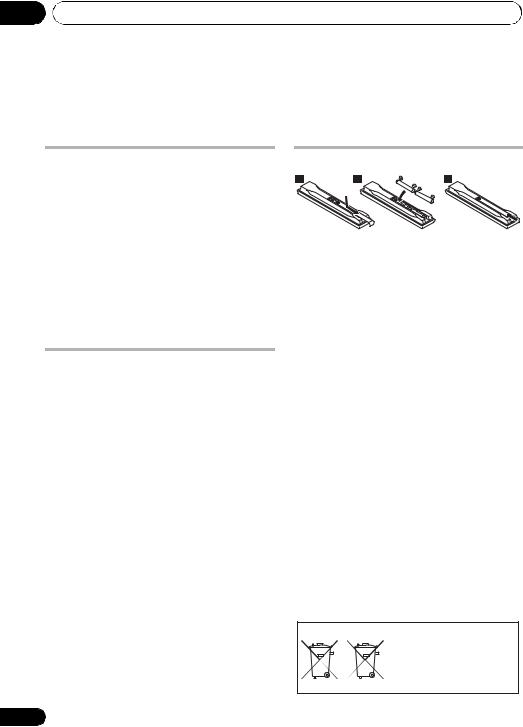
01 Before you start
Chapter 1:
Before you start
Checking what’s in the box
Please check that you’ve received the following supplied accessories:
•Setup microphone (cable: 5 m (16.4 ft.))
•Remote control unit
•AAA size IEC R03 dry cell batteries (to confirm system operation) x2
•AM loop antenna
•FM wire antenna
•iPod cable
•These operating instructions
Installing the receiver
•When installing this unit, make sure to put it on a level and stable surface.
Don’t install it on the following places:
–on a color TV (the screen may distort)
–near a cassette deck (or close to a device that gives off a magnetic field). This may interfere with the sound.
–in direct sunlight
–in damp or wet areas
–in extremely hot or cold areas
–in places where there is vibration or other movement
–in places that are very dusty
–in places that have hot fumes or oils (such as a kitchen)
•Do not touch this receiver’s bottom panel while the power is on or just after it is turned off. The bottom panel becomes hot when the power is on (or right after it is turned off) and could cause burns.
Loading the batteries
The batteries included with the unit are to check initial operations; they may not last over a long period. We recommend using alkaline batteries that have a longer life.
 CAUTION
CAUTION
Incorrect use of batteries may result in such hazards as leakage and bursting. Observe the following precautions:
•Never use new and old batteries together.
•Insert the plus and minus sides of the batteries properly according to the marks in the battery case.
•Batteries with the same shape may have different voltages. Do not use different batteries together.
•When disposing of used batteries, please comply with governmental regulations or environmental public instruction’s rules that apply in your country or area.
•WARNING
Do not use or store batteries in direct sunlight or other excessively hot place, such as inside a car or near a heater. This can cause batteries to leak, overheat, explode or catch fire. It can also reduce the life or performance of batteries.
(Symbol examples for batteries)
These symbols are only valid in the European Union.
Pb |
K058c_A1_En |
|
8
En
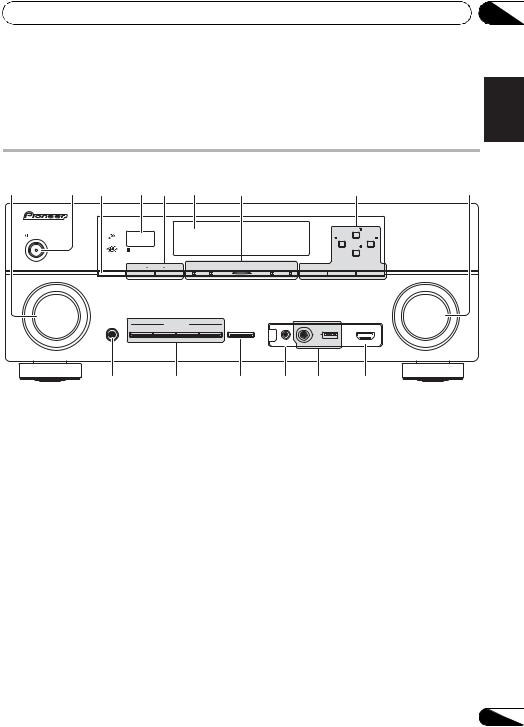
Controls and displays
Chapter 2:
Controls and displays
02
English
Front panel |
|
|
|
|
|
|
|
|
|
|
|
|
Deutsch |
|
1 |
2 |
3 |
4 |
5 |
6 |
7 |
|
|
|
8 |
|
|
9 |
|
|
|
|
|
|
|
|||||||||
|
|
|
|
|
|
|
|
|
|
|
AUDIO/ VIDEO MULTICHANNEL RECEIVER |
VSX-1020 |
|
|
|
|
PHASE |
|
|
|
|
|
|
|
TUNE |
|
|
|
|
|
|
CONTROL |
|
|
|
|
|
|
|
|
|
|
|
|
|
STANDBY/ON |
|
|
|
|
|
|
|
|
PRESET |
PRESET |
MASTER |
|
Français |
|
INPUT |
|
|
|
|
|
|
|
|
|
||||
|
|
|
|
|
|
|
|
|
|
TUNE |
|
|
|
|
|
|
|
|
|
ADVANCED |
|
|
iPod |
|
|
|
|
|
|
|
|
SPEAKERS |
CONTROL |
MULTI-ZONE ON/OFF |
MCACC |
PQLS |
HDMI |
iPhone |
BAND |
TUNER EDIT |
ENTER |
|
|
|
|
SELECTOR |
|
|
|
|
|
|
|
|
|
|
VOLUME |
|
|
PHONES |
LISTENING MODE |
iPod iPhone |
|
|
|
AUTO/ALC/DIRECT |
STEREO |
STANDARD ADV SURROUND |
DIRECT CONTROL |
|
VIDEO CAMERA |
|
|
|
|
iPod |
|
|
|
|
|
iPhone |
|
|
|
|
MCACC |
USB |
HDMI 5 |
|
|
|
SETUP MIC |
|
|
10 11 12 13 14 15
1INPUT SELECTOR dial
Select an input function.
2STANDBY/ON
Switches the receiver between on and standby.
3 SPEAKERS
See Switching the speaker terminal on page 72.
4 Remote sensor
Receives the signals from the remote control (see Operating range of remote control unit on page 13).
5 MULTI-ZONE controls
If you’ve made MULTI-ZONE connections (see MULTI-ZONE setup on page 30) use these controls to control the sub zone from the main zone (see Using the MULTI-ZONE controls on page 72).
6 Character display
See Display on page 10.
7Indicators
ADVANCED MCACC – Lights when EQ is set to ON in the AUDIO PARAMETER menu.
PQLS – Lights when the PQLS feature is active (page 65).
HDMI – Blinks when connecting an HDMIequipped component; lights when the component is connected (page 23).
iPod/iPhone – Lights to indicate iPod/ iPhone is connected (page 43).
8Tuner controls
BAND – Switches between AM and FM radio bands (page 48).
TUNER EDIT – Use with TUNE /,
PRESET /and ENTER to memorize and name stations for recall (page 48).
TUNE / – Find radio frequencies (page 48).
PRESET / – Find preset stations (page 48).
Español Nederlands Italiano
9
En

02 Controls and displays
9MASTER VOLUME dial
10PHONES jack
Connect the headphones. When the headphones are connected, there is no sound output from the speakers.
11Listening mode buttons
AUTO/ALC/DIRECT – Switches between Auto Surround (page 56), Auto Level Control mode and Stream Direct mode (page 59). STEREO – Switches between stereo playback and Front Stage Surround Advance modes (page 59).
STANDARD – Press for Standard decoding and to switch between the various 2Pro Logic IIx and Neo:6 options (page 56).
ADV SURROUND – Switch between the various surround modes (page 58).
12iPod iPhone DIRECT CONTROL
Change the receiver’s input to the iPod and enable iPod operations on the iPod (page 44).
13MCACC SETUP MIC jack
Connect the supplied microphone (page 37).
14 iPod/iPhone/USB terminals
Connect your Apple iPod as an audio and video source, or connect a USB device for audio and photo playback (page 33).
15 HDMI input connector
Use for connection to compatible HDMI device (Video camera, etc.)(page 32).
Display
|
1 |
|
2 |
|
3 |
|
4 5 |
6 |
7 8 |
9 |
10 |
11 |
12 |
13 |
14 15 |
AUTO |
L |
C |
R |
2DIGITAL PLUS |
DSD PCM |
PQLS |
ALC |
|
TUNED |
|
|
|
|||
|
PCM |
SL |
|
SR |
2TrueHD WMA9Pro |
MULTI-ZONE |
|
ATT STEREO |
|
|
|
||||
HDMI |
XC |
DTS HD ES 96/24 |
S.RTRV SOUND UP MIX OVER MONO |
|
|
dB |
|||||||||
DIGITAL |
XL |
XR |
|
|
|
|
|
|
|
|
|
|
|
||
ANALOG |
|
LFE |
MSTR CD TUNER |
SIRIUS |
DVD |
TV |
|
VIDEO |
|
USB |
[ 4 ] |
|
|||
AUTO SURROUND |
|
CD-R |
iPod |
BD |
DVR |
|
HDMI |
[ 2 ] [ 3 ] |
|
||||||
STREAM DIRECT |
|
|
|
|
|
|
|
|
|
|
|
|
|||
2PROLOGIC |
x Neo:6 |
|
|
|
|
|
|
|
|
|
|
|
|
||
|
ADV.SURROUND |
|
|
|
|
|
|
|
|
|
|
|
|
||
STEREO STANDARD |
|
|
|
|
|
|
|
|
|
|
|
|
|||
SP |
AB |
SLEEP |
|
|
|
|
|
|
|
|
|
|
|
|
|
8 |
16 |
17 |
18 |
|
|
|
19 |
|
|
|
|
|
20 |
||
1 SIGNAL indicators
Light to indicate the currently selected input signal. AUTO lights when the receiver is set to select the input signal automatically (page 60).
2 Program format indicators
Light to indicate the channels being digital input.
L/R – Left front/Right front channel C – Center channel
SL/SR – Left surround/Right surround channel LFE – Low frequency effects channel (the (( )) indicators light when an LFE signal is being input) XL/XR – Two channels other than the ones above XC – Either one channel other than the ones above, the mono surround channel or matrix encode flag
3 Digital format indicators
Light when a signal encoded in the corresponding format is detected.
2DIGITAL – Lights with Dolby Digital decoding.
2DIGITAL PLUS – Lights with Dolby Digital Plus decoding.
2TrueHD – Lights with Dolby TrueHD decoding. DTS – Lights with DTS decoding.
DTS HD – Lights with DTS-HD decoding. 96/24 – Lights with DTS 96/24 decoding.
WMA9 Pro – Lights to indicate that a WMA9 Pro signal is being decoded.
DSD PCM – Light during DSD (Direct Stream Digital) to PCM conversion with SACDs.
PCM – Lights during playback of PCM signals. MSTR – Lights during playback of DTS-HD Master Audio signal.
10
En
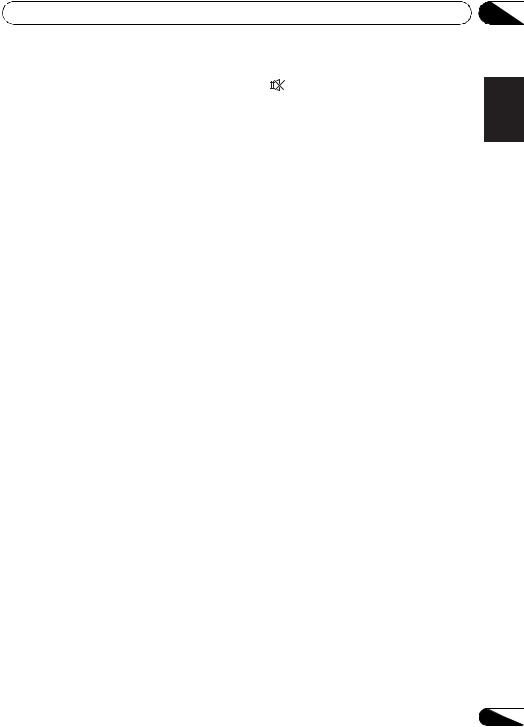
Controls and displays |
02 |
4 MULTI-ZONE
Lights when the MULTI-ZONE feature is active (page 72).
5 SOUND
Lights when any of the Midnight, Loudness or tone controls feature is selected (page 67). Lights when Dialog Enhancement is switched on.
6 PQLS
Lights when the PQLS feature is active (page 65).
7 S.RTRV
Lights when the Sound Retriever function is active (page 68).
8Listening mode indicators
AUTO SURROUND – Lights when the Auto Surround feature is switched on (page 56).
ALC – Lights when the ALC (Auto level control) mode is selected (page 59).
STREAM DIRECT – Lights when Direct/ Pure Direct is selected (page 59).
ADV.SURROUND – Lights when one of the Advanced Surround modes has been selected (page 58).
STEREO – Lights when stereo listening is switched on (page 58).
STANDARD – Lights when one of the Standard Surround modes is switched on (page 56).
9 (PHASE CONTROL)
(PHASE CONTROL)
Lights when the Phase Control is switched on (page 61).
10 Analog signal indicators
Light to indicate reducing the level of an analog signal (page 74).
11Tuner indicators
TUNED – Lights when a broadcast is being received.
STEREO – Lights when a stereo FM broadcast is being received in auto stereo mode.
MONO – Lights when the mono mode is set using MPX.
12
Lights when the sound is muted (page 13).
13Master volume level
Shows the overall volume level.
“---” indicates the minimum level, and “+12dB” indicates the maximum level.
14Input function indicators
Light to indicate the input function you have selected.
15 Scroll indicators
Light when there are more selectable items when making the various settings.
16 Speaker indicators
Indicates the speaker terminal, A and/or B, to which audio signal output is currently set (page 72).
17 SLEEP
Lights when the receiver is in sleep mode (page 74).
18Matrix decoding format indicators
2PRO LOGIC IIx – This lights to indicate 2Pro Logic II / 2Pro Logic IIx decoding (page 56).
Neo:6 – When one of the Neo:6 modes of the receiver is on, this lights to indicate Neo:6 processing (page 56).
19Character display
Displays various system information.
20 Remote control mode indicator
Lights to indicate the receiver’s remote control mode setting. (Not displayed when set to 1.) (page 76)
Español Nederlands Italiano Français Deutsch English
11
En
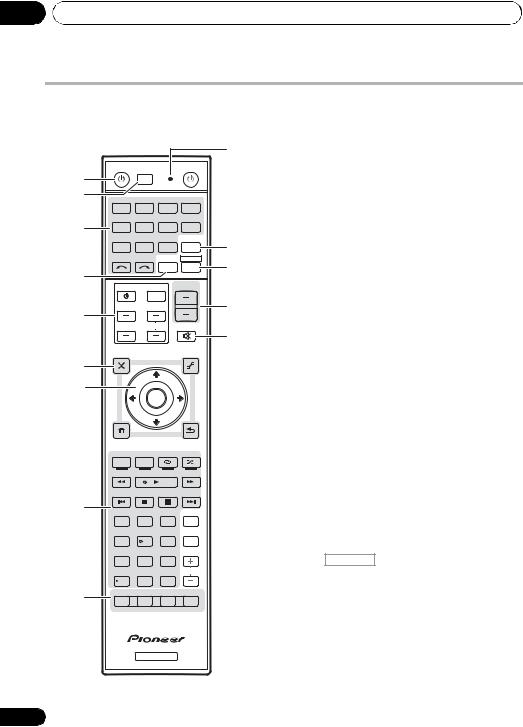
02 Controls and displays
Remote control
This section explains how to operate the remote control for the receiver.
|
|
|
|
|
10 |
|
|
RECEIVER MULTI |
|
|
SOURCE |
||
1 |
|
OPERATION |
|
|
||
|
R.SETUP |
|
|
|||
2 |
|
|
|
|||
BD |
DVD |
DVR/BDR |
HDMI |
|||
3 |
TV |
CD |
NET RADIO ADAPTER |
|||
iPod USB TUNER |
SIRIUS |
TV CTRL |
||||
|
||||||
|
|
|
|
|
11 |
|
|
INPUT SELECT |
ZONE 2 |
RECEIVER |
|||
4 |
|
|
|
|
12 |
|
|
|
|
MASTER |
|||
|
|
INPUT |
VOLUME |
|||
5 |
TV CONTROL |
|
13 |
|||
|
|
|
|
|
||
The remote has been conveniently color-coded according to component control using the following system:
•White – Receiver control, TV Control
•Blue – Other controls (See page 43, 45, 48, 50, 52, 53 and 82.)
1 RECEIVER
This switches between standby and on for this receiver.
2MULTI OPERATION – Use to perform multi operations (page 80).
R.SETUP – Use to input the preset code when making remote control settings and to set the remote control mode (page 76).
6
7
CH |
VOL |
MUTE |
3 |
Input function buttons |
|
|
|
14 |
|||
AUDIO |
|
VIDEO |
Press to select control of other components |
||
PARAMETER |
|
PARAMETER |
(page 76). |
||
LIST |
TUNE |
TOOLS |
|||
4 |
ZONE 2 |
||||
BAND |
|
GUIDE |
|||
TOP MENU |
|
T.EDIT |
|
|
|
PRESET |
ENTER |
PRESET |
Switch to perform operations in the sub zone |
||
|
|
||||
(page 73).
8
9
CATEGORY |
|
|
|
RETURN |
HOME |
TUNE |
|
||
MENU |
|
|||
|
|
|
||
iPod CTRL |
|
|
|
|
|
PGM |
MEMORY |
MENU |
|
HDD |
DVD |
|
|
|
|
PHASE CTRL |
STATUS |
||
TV/DTV |
MPX |
PQLS |
|
|
S.RETRIEVER |
|
MIDNIGHT AUDIO |
||
1 |
2 |
|
3 |
|
SIGNAL SEL MCACC |
SLEEP |
INFO |
||
4 |
5 |
|
6 |
DISP |
CH LEVEL A.ATT |
DIMMER |
|
||
7 |
8 |
|
9 |
|
D.ACCESS |
|
|
CLASS |
CH |
|
|
|
||
/CLR |
0 |
|
ENTER |
|
AUTO/ALC/ |
STEREO STANDARD ADV SURR |
|||
DIRECT |
||||
 LISTENING MODE
LISTENING MODE 
RECEIVER
5 TV CONTROL buttons
These buttons are dedicated to control the TV assigned to TV CTRL button.
– Turn on/off the power of the TV.
INPUT – Select the TV input signal.
CH +/– – Select channels.
VOL +/– – Adjust the volume on your TV.
6 Receiver controls
Press RECEIVER first to access:
AUDIO PARAMETER – Use to access the Audio options (page 67).
VIDEO PARAMETER – Use to access the Video options (page 70).
HOME MENU – Use to access the Home Menu (pages 37, 40, 63, 85, 99 and 105).
RETURN – Press to confirm and exit the current menu screen.
12
En
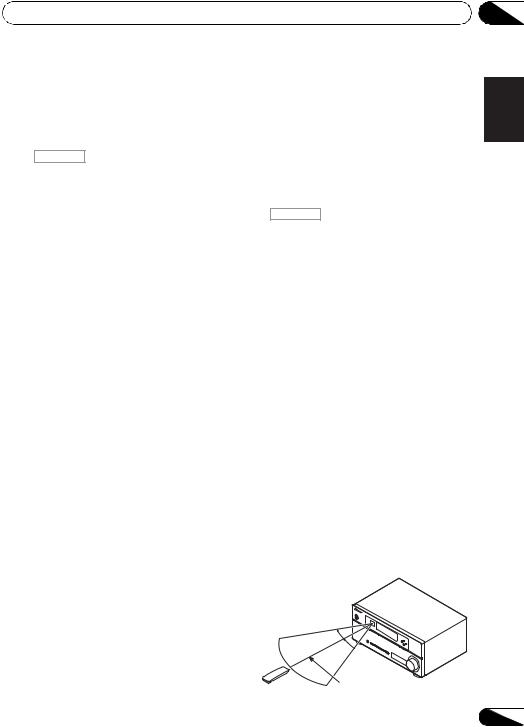
Controls and displays |
02 |
7 / / /, ENTER
Use the arrow buttons when setting up your surround sound system (page 85) and the Audio or Video options (page 67 or 70).
8 Receiver controls
Press RECEIVER first to access:
PHASE CTRL – Switch on/off Phase Control (page 61).
STATUS – Check selected receiver settings (page 74).
PQLS – Select PQLS setting (page 65).
S.RETRIEVER – Press to restore CD quality sound to compressed audio sources (page 68).
MIDNIGHT – Switches to Midnight or Loudness listening (page 67).
SIGNAL SEL – Select an input signal (page 60).
MCACC – Switch between MCACC presets (page 60).
SLEEP – Use to put the receiver in sleep mode and select the amount of time before sleep (page 74).
CH LEVEL – Press repeatedly to select a channel, then use /to adjust the level (page 102).
A.ATT – Attenuates (lowers) the level of an analog input signal to prevent distortion (page 74).
DIMMER – Dims or brightens the display (page 74).
9LISTENING MODE controls AUTO/ALC/DIRECT – Switches between Auto Surround (page 56), Auto Level Control mode and Stream Direct mode (page 59).
STEREO – Switches between stereo playback and Front Stage Surround Advance modes (page 59).
STANDARD – Press for Standard decoding and to switch between the various 2Pro Logic IIx and Neo:6 options (page 56).
ADV SURR – Switch between the various surround modes (page 58).
10 Remote control LED
Lights when a command is sent from the remote control (page 76).
11 TV CTRL
Set preset code of your TV’s manufacturer when controlling TV (page 77).
12 RECEIVER
Switches the remote to control the receiver (used to select the white commands above the number buttons (SIGNAL SEL, etc.)).
Switch to perform operations in the main zone. Also use to set up surround sound.
13MASTER VOLUME +/–
Set the listening volume.
14MUTE
Mutes the sound or restores the sound if it has been muted (adjusting the volume also restores the sound).
Operating range of remote control unit
The remote control may not work properly if:
•There are obstacles between the remote control and the receiver’s remote sensor.
•Direct sunlight or fluorescent light is shining onto the remote sensor.
•The receiver is located near a device that is emitting infrared rays.
•The receiver is operated simultaneously with another infrared remote control unit.
30° 
 30°
30° 
7 m (23 ft.)
Español Nederlands Italiano Français Deutsch English
13
En
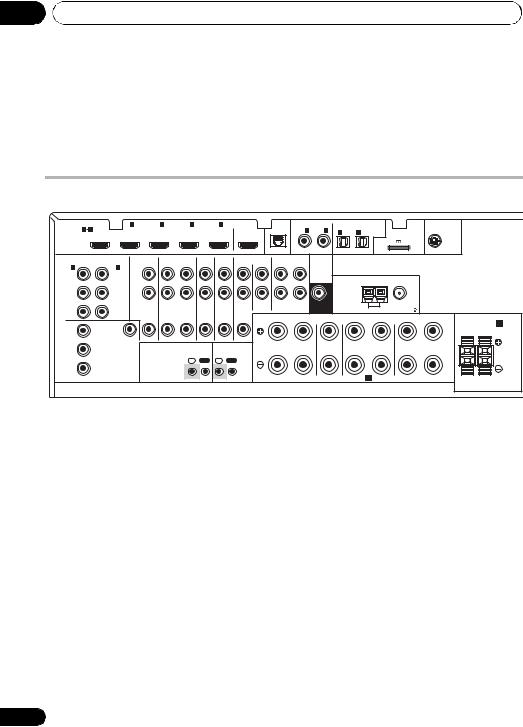
03 Connecting your equipment
Chapter 3:
Connecting your equipment
This receiver provides you with many connection possibilities, but it doesn’t have to be difficult. This page explains the kinds of components you can connect to make up your home theater system.
Rear panel
HDMI |
BD IN |
IN 1 |
IN 2 |
IN 3 |
IN 4 |
OUT |
LAN |
COAXIAL ASSIGNABLE |
|
|
OPTICAL |
|
SIRIUS |
|
ASSIGNABLE 1 |
4 |
|
|
|
|
|
(10/100) |
IN 1 |
IN 2 |
IN 1 |
IN 2 |
ASSIGNABLE |
|
|
|
|
|
|
|
|
|
|
|
|
ADAPTER PORT |
IN |
|||
|
|
|
|
|
|
|
|
|
|
|
|
(OUTPUT 5 V |
100 mA MAX) |
|
|
|
|
|
|
|
|
|
(DVD) |
(CD) |
(TV/SAT) |
(DVR/BDR) |
|
|
|
COMPONENT VIDEO |
|
AUDIO |
|
|
|
|
PRE OUT |
|
|
|
|
|
||
ASSIGNABLE |
IN 2 |
|
|
|
|
|
|
|
|
|
||||
IN 1 |
|
|
|
|
|
|
|
|
|
|
|
|
|
|
(DVD) |
|
(DVR/BDR) |
L |
|
|
|
|
|
|
|
|
|
|
|
Y |
|
Y |
|
|
|
|
|
|
|
|
|
|
|
|
|
|
|
|
|
|
|
|
|
|
|
|
|
||
|
|
|
|
|
|
|
|
|
|
ANTENNA |
|
|
|
|
PB |
|
PB |
R |
|
|
|
|
|
|
|
|
|
|
|
|
ZONE 2 |
DVR/BDR |
DVD |
TV/SAT |
VIDEO |
CD |
CD-R/TAPE |
SUBWOOFER |
|
|
|
|
|
|
PR |
OUT |
OUT |
IN |
IN |
IN |
IN |
IN |
OUT IN |
|
AM LOOP |
FM UNBAL 75 |
|
|
|
PR |
|
|
|
|
|
|
FRONT |
CENTER |
SURROUND |
|
SURROUND BACK |
|
SPEAKERS |
|
|
|
|
|
|
|
|
|
|
|
|||||
|
MONITOR |
|
|
|
|
|
|
R |
L |
R |
L R |
L(Single) |
FRONT HEIGHT/WIDE/ B |
|
Y |
OUT |
|
|
|
|
|
|
|
|
|
|
|
R |
L |
|
VIDEO |
|
|
|
|
|
|
|
|
|
|
|
|
|
PB |
|
|
|
IR |
CONTROL |
|
|
|
|
|
|
|
|
|
|
|
|
|
|
|
|
|
|
|
|
|
|||
|
|
|
IN |
OUT |
IN OUT |
|
|
|
|
|
|
|
|
|
PR |
|
|
|
|
|
|
|
|
|
|
|
|
|
|
|
|
|
|
|
|
|
|
|
SPEAKERS A |
|
|
|
|
|
 CAUTION
CAUTION  Important
Important
•Before making or changing the connections, switch off the power and disconnect the power cord from the power outlet. Plugging in should be the final step.
•The input functions below are assigned by default to the receiver’s different input terminals. Refer to The Input Setup menu on page 40 to change the assignments if other connections are used.
Input |
|
Input Terminals |
function |
Digital |
HDMI Component |
|
|
|
DVD |
COAX-1 |
IN 1 |
|
|
|
BD |
|
(BD) |
|
|
|
TV/SAT |
OPT-1 |
|
|
|
|
DVR/BDR |
OPT-2 |
IN 2 |
|
|
|
HDMI 1-4 |
|
(HDMI-1-4) |
|
|
|
HDMI 5 |
|
(HDMI-5) |
(front panel) |
|
|
|
|
|
CD |
COAX-2 |
|
|
|
|
14
En
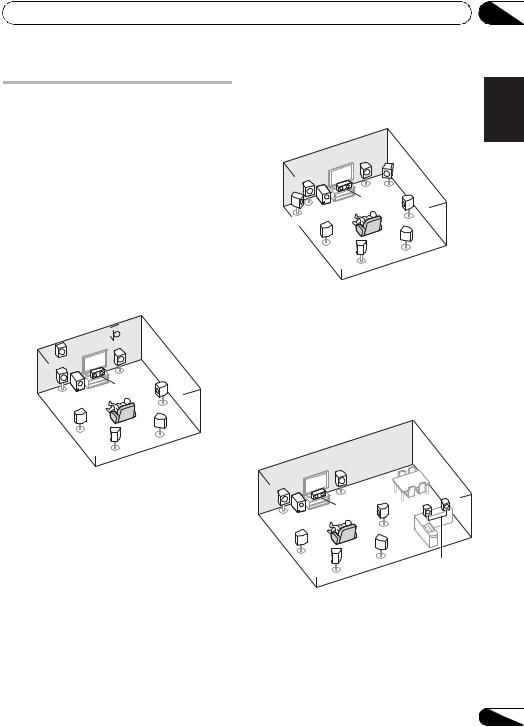
Connecting your equipment
Determining the speakers’ application
This unit permits you to build various surround systems, in accordance with the number of speakers you have.
•Be sure to connect speakers to the front left and right channels (L and R).
•It is also possible to only connect one of the surround back speaker (SB) or neither.
Choose one from Plans [A] to [E] below.
[A] 9.1 channel surround system (Front height)
*Default setting
• Speaker System setting: Normal(SB/FH)
 FHR
FHR
FHL |
|
|
|
R |
|
L |
|
|
C |
SR |
|
|
||
SW |
|
|
SL |
SBR |
|
SBL |
||
|
A 9.1 ch surround system connects the left and right front speakers (L/R), the center speaker (C), the left and right front height speakers (FHL/FHR), the left and right surround speakers (SL/SR), the left and right surround back speakers (SBL/SBR), and the subwoofer (SW).
This surround system produces a more true-to- life sound from above.
03
[B] 9.1 channel surround system (Front |
English |
||
wide) |
|
|
|
|
|
|
|
• Speaker System setting: Normal(SB/FW) |
|
||
R |
|
|
Deutsch |
L |
FWR |
|
|
|
|
||
|
|
|
|
C |
|
SR |
|
|
|
|
|
SW |
|
|
|
FWL |
|
|
Français |
SL |
|
SBR |
|
|
|
||
|
|
|
|
SBL |
|
|
|
This plan replaces the left and right front |
|
||
height speakers shown in [A] with the left and |
Italiano |
||
sound over a wider area. |
|
|
|
right front wide speakers (FWL/FWR). |
|
||
This surround system produces a true-to-life |
|
||
[C] 7.1 channel surround system & |
Nederlands |
||
Speaker B connection |
|
|
|
|
|
|
|
• Speaker System setting: Speaker B |
|
||
R |
|
|
Español |
C |
|
|
|
L |
|
|
|
|
|
R |
|
|
SR |
L |
|
SW |
|
|
|
SL |
SBR |
|
|
|
Plan C |
|
|
SBL |
|
Speaker B |
|
|
|
|
|
With these connections you can simultaneously enjoy 5.1-channel surround sound in the main zone with stereo playback of the same sound on the B speakers. The same connections also allow for 7.1-channel surround sound in the main zone when not using the B speakers.
15
En
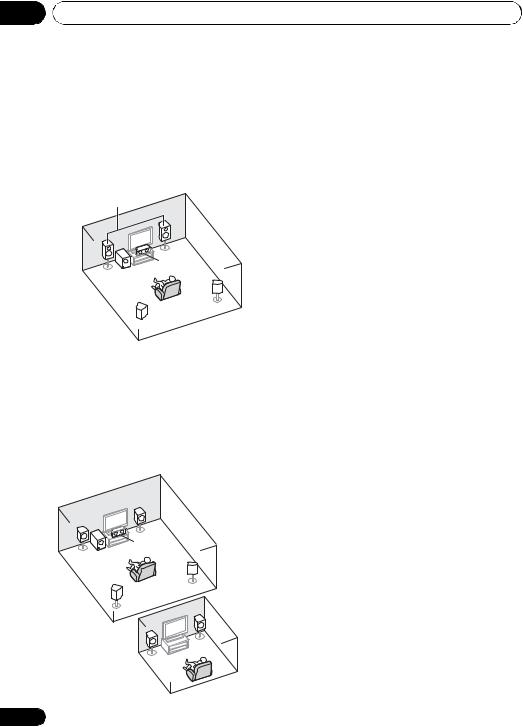
03 Connecting your equipment
[D] 5.1 channel surround system & Front Bi-amping connection (High quality surround)
• Speaker System setting: Front Bi-Amp
Bi-amping connection of the front speakers for high sound quality with 5.1-channel surround sound.
Plan D
Front Bi-Amp
R
L
C
SW
SR
 SL
SL
[E] 5.1 channel surround system & ZONE 2 connection (Multi Zone)
• Speaker System setting: ZONE 2
With these connections you can simultaneously enjoy 5.1-channel surround sound in the main zone with stereo playback on another component in ZONE 2 (The selection of input devices is limited.)
|
Main zone |
R |
|
L |
|
C |
|
SW |
|
|
SR |
SL |
Sub zone |
|
R |
Plan E |
L |
|
|
ZONE 2 |
|
16
 Important
Important
•The Speaker System setting must be made if you use any of the connections shown above other than [A] (see Speaker system setting on page 100).
•Sound does not come through simultaneously from the front height, front wide, speaker B and surround back speakers. Output speakers are different depending on the input signal or listening mode.
Other speaker connection
•Your favorite speaker connections can be selected even if you have fewer than 5.1 speakers (except front left/right speakers).
•When not connecting a subwoofer, connect speakers with low frequency reproduction capabilities to the front channel. (The subwoofer’s low frequency component is played from the front speakers, so the speakers could be damaged.)
•After connecting, be sure to conduct the Auto MCACC (speaker environment setting) procedure.
See Automatically setting up for surround sound (Auto MCACC) on page 37.
En
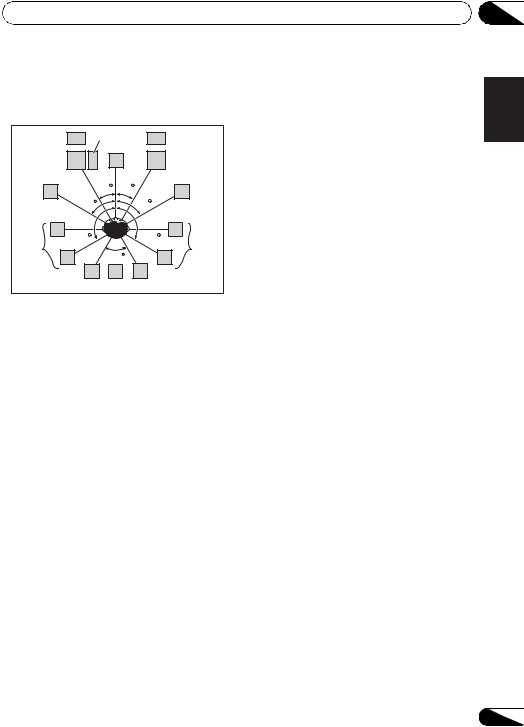
Connecting your equipment |
03 |
Placing the speakers
Refer to the chart below for placement of speakers you intend to connect.
|
FHL |
SW |
C |
FHR |
|
|
|||
|
|
|
|
|
|
L |
|
|
R |
FWL |
|
30 |
30 |
FWR |
|
|
|
||
|
|
60 |
|
60 |
SL |
|
120 |
|
120 |
|
|
60 |
SR |
|
|
|
|
|
SBL SB SBR
•Place the surround speakers at 120º from the center. If you, (1) use the surround back speaker, and, (2) don’t use the front height speakers / front wide speakers, we recommend placing the surround speaker right beside you.
•If you intend to connect only one surround back speakers, place it directly behind you.
•Place the left and right front height speakers at least 1 m (3.3 ft.) directly above the left and right front speakers.
Some tips for improving sound quality
Where you put your speakers in the room has a big effect on the quality of the sound. The following guidelines should help you to get the best sound from your system.
•The subwoofer can be placed on the floor. Ideally, the other speakers should be at about ear-level when you’re listening to them. Putting the speakers on the floor (except the subwoofer), or mounting them very high on a wall is not recommended.
•For the best stereo effect, place the front speakers 2 m to 3 m (6 ft. to 9 ft.) apart, at equal distance from the TV.
•If you’re going to place speakers around your CRT TV, use shielded speakers or place the speakers at a sufficient distance from your CRT TV.
•If you’re using a center speaker, place the front speakers at a wider angle. If not, place them at a narrower angle.
•Place the center speaker above or below the TV so that the sound of the center channel is localized at the TV screen. Also, make sure the center speaker does not cross the line formed by the leading edge of the front left and right speakers.
•It is best to angle the speakers towards the listening position. The angle depends on the size of the room. Use less of an angle for bigger rooms.
•Surround and surround back speakers should be positioned 60 cm to 90 cm (2 ft. to 3 ft.) higher than your ears and tilted slight downward. Make sure the speakers don’t face each other. For DVD-Audio, the speakers should be more directly behind the listener than for home theater playback.
•Try not to place the surround speakers farther away from the listening position than the front and center speakers. Doing so can weaken the surround sound effect.
Español Nederlands Italiano Français Deutsch English
17
En

03 Connecting your equipment
Connecting the speakers
Each speaker connection on the receiver comprises a positive (+) and negative (–) terminal. Make sure to match these up with the terminals on the speakers themselves.
 CAUTION
CAUTION
•These speaker terminals carry
HAZARDOUS LIVE voltage. To prevent the risk of electric shock when connecting or disconnecting the speaker cables, disconnect the power cord before touching any uninsulated parts.
•Make sure that all the bare speaker wire is twisted together and inserted fully into the speaker terminal. If any of the bare speaker wire touches the back panel it may cause the power to cut off as a safety measure.
Bare wire connections
A-Speaker terminals:
1Twist exposed wire strands together.
2Loosen terminal and insert exposed wire.
3Tighten terminal.
1 |
2 |
3 |
10 mm (3/8 in.)
Banana plug connections
(A-Speaker terminals only)
If you want to use speaker cables terminated with banana plugs, screw the speaker terminal fully shut, then plug the banana plug into the end of the speaker terminal.
 Important
Important
•Please refer to the manual that came with your speakers for details on how to connect the other end of the speaker cables to your speakers.
•Use an RCA cable to connect the subwoofer. It is not possible to connect using speaker cables.
 CAUTION
CAUTION
•Make sure that all speakers are securely installed. This not only improves sound quality, but also reduces the risk of damage or injury resulting from speakers being knocked over or falling in the event of external shocks such as earthquakes.
B-Speaker terminals:
1Twist exposed wire strands together.
2Push open the tabs and insert exposed wire.
3Release the tabs.
1 |
2 |
3 |
10 mm (3/8 in.)
18
En

Connecting your equipment
Installing your speaker system
At the very least, front left and right speakers only are necessary. Note that your main surround speakers should always be connected as a pair, but you can connect just one surround back speaker if you like (it must be connected to the left surround back terminal).
The front height terminals can also be used for the front wide and Speaker B.
|
Front height setting |
|
|
|
Front height right |
Front height left |
|
|
Front wide setting |
|
|
|
Front wide right |
Front wide left |
|
|
Speaker B setting |
|
|
|
Speaker B - right |
Speaker B - left |
|
Front right |
Center |
Subwoofer |
Front left |
|
|
||
|
|
LINE LEVEL |
|
|
|
INPUT |
|
HDMI |
BD IN |
IN 1 |
IN 2 |
IN 3 |
IN 4 |
OUT |
LAN |
COAXIAL ASSIGNABLE |
|
|
OPTICAL |
|
SIRIUS |
|
ASSIGNABLE 1 |
4 |
|
|
|
|
|
(10/100) |
IN 1 |
IN 2 |
IN 1 |
IN 2 |
ASSIGNABLE |
|
|
|
|
|
|
|
|
|
|
|
|
ADAPTER PORT |
IN |
|||
|
|
|
|
|
|
|
|
|
|
|
|
(OUTPUT 5 V |
100 mA MAX) |
|
|
|
|
|
|
|
|
|
(DVD) |
(CD) |
(TV/SAT) |
(DVR/BDR) |
|
|
|
COMPONENT VIDEO |
|
AUDIO |
|
|
|
|
|
OUT |
|
|
|
|
|
|
ASSIGNABLE |
IN 2 |
|
|
|
|
|
|
|
|
|
|
|
||
IN 1 |
|
|
|
|
|
|
|
|
|
|
|
|
|
|
(DVD) |
|
(DVR/BDR) |
L |
|
|
|
|
|
|
|
|
|
|
|
Y |
|
Y |
|
|
|
|
|
|
|
|
|
|
|
|
|
|
|
|
|
|
|
|
|
|
ANTENNA |
|
|
|
|
PB |
|
PB |
R |
|
|
|
|
|
|
|
|
|
|
|
|
ZONE 2 |
DVR/BDR |
DVD |
TV/SAT |
VIDEO |
CD |
CD-R/TAPE |
SUBWOOFER |
|
|
|
|
|
|
PR |
OUT |
OUT |
IN |
IN |
IN |
IN |
IN |
OUT IN |
|
AM LOOP |
FM UNBAL 75 |
|
|
|
PR |
|
|
|
|
|
|
FRONT |
CENTER |
SURROUND |
|
SURROUND BACK |
|
SPEAKERS |
|
|
|
|
|
|
|
|
|
|
|
|||||
|
MONITOR |
|
|
|
|
|
|
R |
L |
R |
L R |
L(Single) |
FRONT HEIGHT/WIDE/ B |
|
Y |
OUT |
|
|
|
|
|
|
|
|
|
|
|
R |
L |
|
VIDEO |
|
|
|
|
|
|
|
|
|
|
|
|
|
PB |
|
|
|
IR |
CONTROL |
|
|
|
|
|
|
|
|
|
|
|
|
|
|
|
|
|
|
|
|
|
|||
|
|
|
IN |
OUT |
IN OUT |
|
|
|
|
|
|
|
|
|
PR |
|
|
|
|
|
|
|
|
|
|
|
|
|
|
|
|
|
|
|
|
|
|
|
SPEAKERS A |
|
|
|
|
|
|
The surround back terminals |
|
|
|
can also be used for Zone 2. |
|
|
|
5.1 ch surround setting |
|
|
|
No connect |
No connect |
|
|
6.1 ch surround setting |
|
|
Surround right |
No connect |
Surround back |
Surround left |
7.1 ch surround setting |
|||
|
Surround back right |
Surround back left |
|
|
ZONE 2 setting |
|
|
|
ZONE 2 - right |
ZONE 2 - left |
|
03
Español Nederlands Italiano Français Deutsch English
19
En
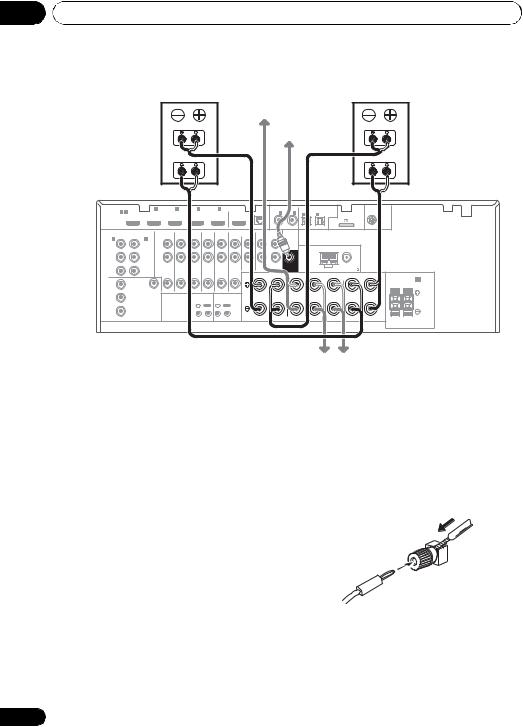
03 Connecting your equipment
Bi-amping your speakers
Front right |
Center |
Front left |
|
High |
High |
|
|
Subwoofer |
Bi-amp compatible |
Low |
Low |
|
Bi-amp compatible |
|
speaker |
|
speaker |
HDMI |
BD IN |
IN 1 |
IN 2 |
IN 3 |
IN 4 |
OUT |
LAN |
COAXIAL ASSIGNABLE |
|
|
OPTICAL |
|
SIRIUS |
|
ASSIGNABLE 1 |
4 |
|
|
|
|
|
(10/100) |
IN 1 |
IN 2 |
IN 1 |
IN 2 |
ASSIGNABLE |
|
|
|
|
|
|
|
|
|
|
|
|
ADAPTER PORT |
IN |
|||
|
|
|
|
|
|
|
|
|
|
|
|
(OUTPUT 5 V |
100 mA MAX) |
|
|
|
|
|
|
|
|
|
(DVD) |
(CD) |
(TV/SAT) |
(DVR/BDR) |
|
|
|
COMPONENT VIDEO |
|
AUDIO |
|
|
|
|
|
OUT |
|
|
|
|
|
|
ASSIGNABLE |
IN 2 |
|
|
|
|
|
|
|
|
|
|
|||
IN 1 |
|
|
|
|
|
|
|
|
|
|
|
|
|
|
(DVD) |
|
(DVR/BDR) |
L |
|
|
|
|
|
|
|
|
|
|
|
Y |
|
Y |
|
|
|
|
|
|
|
|
|
|
|
|
|
|
|
|
|
|
|
|
|
|
ANTENNA |
|
|
|
|
PB |
|
PB |
R |
|
|
|
|
|
|
|
|
|
|
|
|
ZONE 2 |
DVR/BDR |
DVD |
TV/SAT |
VIDEO |
CD |
CD-R/TAPE |
SUBWOOFER |
|
|
|
|
|
|
PR |
OUT |
OUT |
IN |
IN |
IN |
IN |
IN |
OUT IN |
|
AM LOOP |
FM UNBAL 75 |
|
|
|
PR |
|
|
|
|
|
|
FRONT |
CENTER |
SURROUND |
|
SURROUND BACK |
|
SPEAKERS |
|
|
|
|
|
|
|
|
|
|
|
|||||
|
MONITOR |
|
|
|
|
|
|
R |
L |
R |
L R |
L(Single) |
FRONT HEIGHT/WIDE/ B |
|
Y |
OUT |
|
|
|
|
|
|
|
|
|
|
|
R |
L |
|
VIDEO |
|
|
|
|
|
|
|
|
|
|
|
|
|
PB |
|
|
|
IR |
CONTROL |
|
|
|
|
|
|
|
|
|
|
|
|
|
|
|
|
|
|
|
|
|
|||
|
|
|
IN |
OUT |
IN OUT |
|
|
|
|
|
|
|
|
|
PR |
|
|
|
|
|
|
|
|
|
|
|
|
|
|
|
|
|
|
|
|
|
|
|
SPEAKERS A |
|
|
|
|
|
Surround right Surround left
Bi-amping is when you connect the high frequency driver and low frequency driver of your speakers to different amplifiers for better crossover performance. Your speakers must be bi-ampable to do this (having separate terminals for high and low) and the sound improvement will depend on the kind of speakers you’re using.
 CAUTION
CAUTION
•Most speakers with both High and Low terminals have two metal plates that connect the High to the Low terminals. These must be removed when you are biamping the speakers or you could severely damage the amplifier. See your speaker manual for more information.
•If your speakers have a removable crossover network, make sure you do not remove it for bi-amping. Doing so may damage your speakers.
Bi-wiring your speakers
Your speakers can also be bi-wired if they support bi-amping.
•With these connections, the Speaker System setting makes no difference.
•To bi-wire a speaker, connect two speaker cords to the speaker terminal on the receiver.
Using a banana plug for the second connection is recommended.
 CAUTION
CAUTION
•Don’t connect different speakers from the same terminal in this way.
•When bi-wiring as well, heed the cautions for bi-amping shown at the left.
20
En

Connecting your equipment |
03 |
Selecting the Speaker system
The front height terminals can be used for front wide and Speaker B connections, in addition to for the front height speakers. Also, the surround back terminals can be used for biamping and ZONE 2 connections, in addition to for the surround back speakers. Make this setting according to the application.
Front height setup
*Default setting
1Connect a pair of speakers to the front height speaker terminals.
See Connecting the speakers on page 18.
2If necessary, select ‘Normal(SB/FH)’ from the Speaker System menu.
See Speaker system setting on page 100 to do this.
Front wide setup
1Connect a pair of speakers to the front height speaker terminals.
See Connecting the speakers on page 18.
2Select ‘Normal(SB/FW)’ from the Speaker System menu.
See Speaker system setting on page 100 to do this.
Speaker B setup
You can listen to stereo playback in another room.
1Connect a pair of speakers to the front height speaker terminals.
See Connecting the speakers on page 18.
2Select ‘Speaker B’ from the Speaker System menu.
See Speaker system setting on page 100 to do this.
Bi-Amping setup
Bi-amping connection of the front speakers for high sound quality with 5.1-channel surround sound.
1Connect a Bi-amp compatible speakers to the front and surround back speaker terminals.
See Bi-amping your speakers on page 20.
2Select ‘Front Bi-Amp’ from the Speaker System menu.
See Speaker system setting on page 100 to do this.
ZONE 2 setup
With these connections you can simultaneously enjoy 5.1-channel surround sound in the main zone with stereo playback on another component in ZONE 2.
1Connect a pair of speakers to the surround back speaker terminals.
See Connecting the speakers on page 18.
2Select ‘ZONE 2’ from the Speaker System menu.
See Speaker system setting on page 100 to do this.
Español Nederlands Italiano Français Deutsch English
21
En

03 Connecting your equipment
About the audio connection
There are several types of audio input and output terminals on this receiver. The receiver selects the first available signal in the following order when you choose AUTO as the input signal:
|
Types of cables and |
Transferable |
|
terminals |
audio signals |
|
HDMI |
HD audio |
priority |
|
|
signal |
Digital (Coaxial) |
Conventional |
|
||
Sound |
|
digital audio |
Digital (Optical) |
|
|
|
|
|
|
RCA (Analog) |
Conventional |
|
(White/Red) |
analog audio |
•With an HDMI cable, video and audio signals can be transferred in high quality over a single cable.
 CAUTION
CAUTION
•When connecting optical cables, be careful when inserting the plug not to damage the shutter protecting the optical socket.
•When storing optical cable, coil loosely. The cable may be damaged if bent around
sharp corners.
About the video converter
The video converter ensures that all video sources are output through all of the MONITOR OUT jacks. The only exception is HDMI: since this resolution cannot be downsampled, you must connect your monitor/TV to the receiver’s HDMI video outputs when connecting this video source.1
If several video components are assigned to the same input function (see The Input Setup menu on page 40), the converter gives priority to HDMI, component, then composite (in that order).
|
Terminal for |
||
|
connection with |
||
qualitypicture |
source device |
||
|
HDMI IN |
|
|
High |
Y |
PB |
PR |
|
VIDEO IN |
|
|
|
COMPONENT |
||
|
|
VIDEO IN |
|
Terminal for connection with TV monitor
HDMI OUT
Y PB PR
COMPONENT VIDEO
MONITOR OUT
VIDEO
MONITOR OUT
 Video signals can be output
Video signals can be output
This product incorporates copyright protection technology that is protected by method claims of certain U.S. patents and other intellectual property rights owned by Macrovision Corporation and other rights owners. Use of this copyright protection technology must be authorized by Macrovision Corporation, and is intended for home and other limited viewing uses only unless otherwise authorized by Macrovision Corporation. Reverse engineering or disassembly is prohibited.
 Note
Note
1 • If the video signal does not appear on your TV, try adjusting the resolution settings on your component or display. Note that some components (such as video game units) have resolutions that may not be converted. In this case, try switching Digital Video Conversion (in Setting the Video options on page 70) OFF.
•The signal input resolutions that can be converted from the component video input for the HDMI output are 480i/ 576i, 480p/576p, 720p and 1080i. 1080p signal cannot be converted.
•Only signals with an input resolution of 480i/576i can be converted from the component video input for the composite MONITOR OUT.
22
En
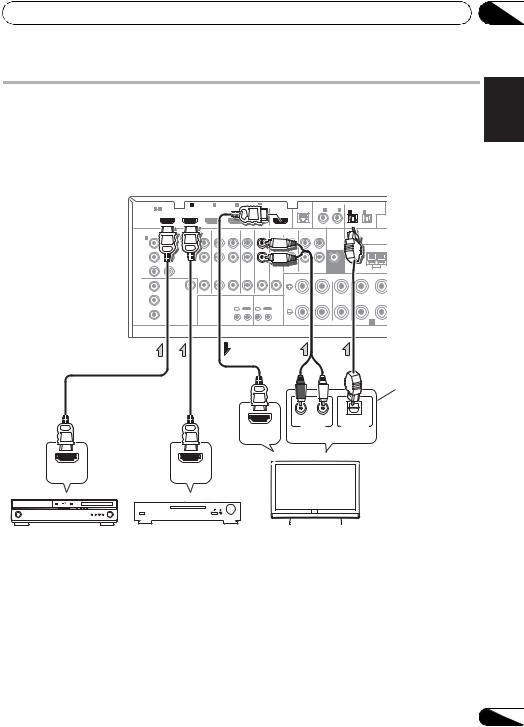
Connecting your equipment
Connecting your TV and playback components
Connecting using HDMI
If you have an HDMI or DVI (with HDCP) equipped component (BD: Blu-ray disc player, etc.), you can connect it to this receiver using a commercially available HDMI cable.
If the TV and playback components support the Control with HDMI feature, the convenient Control with HDMI functions can be used (see Control with HDMI function on page 62).
HDMI |
BD IN |
IN 1 |
IN 2 |
IN 3 |
IN 4 |
OUT |
LAN |
COAXIAL ASSIGNABLE |
|
OPTICAL |
|
ASSIGNABLE 1 |
4 |
|
|
|
|
|
(10/100) |
IN 1 |
IN 2 |
IN 1 |
ASSIGNABLE |
|
|
|
|
|
|
|
|
|
|
IN 2 |
|
|
|
|
|
|
|
|
|
|
|
|
(OUTPUT |
|
|
|
|
|
|
|
|
|
(DVD) |
(CD) |
(TV/SAT) (DVR/BDR) |
|
COMPONENT |
|
|
|
|
|
|
|
|
|
PRE OUT |
|
|
IN 1 |
2 |
|
|
|
|
|
|
|
|
|
|
|
|
|
|
|
|
|
|
|
|
|
|
||
(DVD) |
|
|
|
|
|
|
|
|
|
|
|
|
Y |
Y |
|
|
|
|
|
|
|
|
|
|
|
PB |
B |
|
|
|
|
|
|
|
|
|
|
|
|
ZONE 2 |
DVR/BDR |
DVD |
TV/SAT |
VIDEO |
CD |
CD-R/TAPE |
SUBWOOFER |
|
|
||
PR |
OUT |
OUT |
IN |
IN |
IN |
IN |
IN |
OUT |
IN |
|
|
AM LOOP |
PR |
|
|
|
|
|
|
FRONT |
CENTER |
SURROUND |
|||
|
|
|
|
|
|
|
|
|||||
|
MONITOR |
|
|
|
|
|
|
R |
|
L |
|
R |
|
|
|
|
|
|
|
|
|
|
|
|
|
Y |
OUT |
|
|
|
|
|
|
|
|
|
|
|
|
VIDEO |
|
|
|
|
|
|
|
|
|
|
|
PB |
|
|
|
IR |
CONTROL |
|
|
|
|
|
|
|
|
|
|
|
|
|
|
|
|
|
|||
|
|
|
IN |
OUT |
IN OUT |
|
|
|
|
|
|
|
PR |
|
|
|
|
|
|
|
|
|
|
|
|
|
|
|
|
|
|
|
|
|
|
|
SPEAKERS A |
|
|
|
|
|
|
|
|
|
|
|
|
|
This connection is |
|
|
|
|
|
|
|
|
|
|
|
|
required in order to |
|
|
|
|
|
|
|
|
|
|
|
|
listen to the sound of |
|
|
|
|
|
|
|
|
|
|
|
|
the TV over the receiver. |
|
R ANALOG L |
OPTICAL |
|
HDMI IN |
AUDIO OUT |
DIGITAL OUT |
|
Select one |
|||
|
|||
03
Nederlands Italiano Français Deutsch English
HDMI OUT |
HDMI OUT |
HDMI/DVI-compatible |
|
|
|
|
|
|
|
|
|
|
|
|
|
|
|
|
|
|
Other HDMI/DVI- |
HDMI/DVI-compatible TV |
|||||||||||||||||
Blu-ray disc player |
equipped component |
|
|
|
|
|
|
|
||||||||||
•For input components, connections other than HDMI connections are also possible (see Connecting your DVD player with no HDMI output on page 25).
•If you want to listen to the sound of the TV over the receiver, connect the receiver and TV with audio cables.
Español
23
En

03 Connecting your equipment
About HDMI1
The HDMI connection transfers uncompressed digital video, as well as almost every kind of digital audio that the connected component is compatible with, including DVDVideo, DVD-Audio, SACD, Dolby Digital Plus, Dolby TrueHD, DTS-HD Master Audio (see below for limitations), Video CD/Super VCD and CD. See About the video converter on page 22 for more on HDMI compatibility.
This receiver incorporates High-Definition Multimedia Interface (HDMI®) technology.
This receiver supports the functions described below through HDMI connections.2
•Digital transfer of uncompressed video (contents protected by HDCP (1080p/24, 1080p/60, etc.))
•3D signal transfer3
•Deep Color signal transfer3
•x.v.Color signal transfer3
•Input of multi-channel linear PCM digital audio signals (192 kHz or less) for up to 8 channels
•Input of the following digital audio formats:4
– Dolby Digital, Dolby Digital Plus, DTS, High bitrate audio (Dolby TrueHD, DTS-HD Master Audio, DTS-HD High Resolution Audio), DVD-Audio, CD, SACD (DSD signal), Video CD, Super VCD
•Synchronized operation with components using the Control with HDMI function (see
Control with HDMI function on page 62)
HDMI, the HDMI Logo and High-Definition Multimedia Interface are trademarks or registered trademarks of HDMI Licensing, LLC in the United States and other countries.
“x.v.Color” and x.v.Color logo are trademarks of Sony Corporation.
 Note
Note
1 • An HDMI connection can only be made with DVI-equipped components compatible with both DVI and High Bandwidth Digital Content Protection (HDCP). If you choose to connect to a DVI connector, you will need a separate adaptor (DVI HDMI) to do so. A DVI connection, however, does not support audio signals. Consult your local audio dealer for more information.
•If you connect a component that is not compatible with HDCP, an HDCP ERROR message is displayed on the front panel display. Some components that are compatible with HDCP still cause this message to be displayed, but so long as there is no problem with displaying video this is not a malfunction.
•Depending on the component you have connected, using a DVI connection may result in unreliable signal transfers.
•This receiver supports SACD, Dolby Digital Plus, Dolby TrueHD and DTS-HD Master Audio. To take advantage of these formats, however, make sure that the component connected to this receiver also supports the corresponding format.
2 • Use a High Speed HDMI® cable. If HDMI cable other than a High Speed HDMI® cable is used, it may not work properly.
•When an HDMI cable with a built-in equalizer is connected, it may not operate properly. 3 Signal transfer is only possible when connected to a compatible component.
4 • HDMI format digital audio transmissions require a longer time to be recognized. Due to this, interruption in the audio may occur when switching between audio formats or beginning playback.
•Turning on/off the device connected to this unit's HDMI OUT terminal during playback, or disconnecting/ connecting the HDMI cable during playback, may cause noise or interrupted audio.
24
En
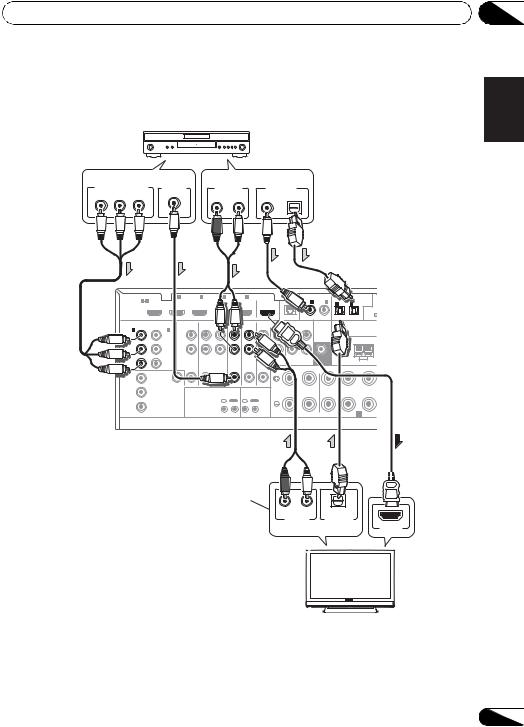
Connecting your equipment |
03 |
Connecting your DVD player with no HDMI output
This diagram shows connections of a TV (with HDMI input) and DVD player (or other playback component with no HDMI output) to the receiver.
|
|
|
|
|
DVD player etc. |
|
Select one |
|
Select one |
||
COMPONENT VIDEO OUT |
VIDEO OUT |
AUDIO OUT |
DIGITAL OUT |
||
PR |
PB |
Y |
R |
ANALOG L |
COAXIAL OPTICAL |
|
|
|
|||
HDMI |
BD IN |
IN 1 |
IN 2 |
IN 3 |
|
IN 4 |
OUT |
1 |
ASSIGNABLE |
|
OPTICAL |
|
|
ASSIGNABLE 1 |
4 |
|
|
|
|
|
|
|
IN |
IN 1 |
ASSIGNABLE |
AD |
|
|
|
|
|
|
|
|
|
|
|
|
IN 2 |
||
|
|
|
|
|
|
|
|
|
|
|
|
(OUTPUT 5 |
|
|
|
|
|
|
|
|
|
|
(DVD) (CD) |
(TV/SAT) |
(DVR/BDR) |
|
|
COMPONENT VIDEO |
|
AUDIO |
|
|
|
|
|
|
PRE OUT |
|
|
|
|
ASSIGNABLE |
|
|
|
|
|
|
|
|
|
|
|||
IN 1 |
IN 2 |
|
|
|
|
|
|
|
|
|
|
|
|
) |
(DVR/BDR) |
L |
|
|
|
|
|
|
|
|
|
|
|
|
Y |
|
|
|
|
|
|
|
|
|
|
|
|
B |
PB |
|
R |
|
|
|
|
|
|
|
|
|
|
|
|
|
ZONE 2 |
DVR/BDR |
DVD |
TV/SAT |
CD-R/TAPE |
SUBWOOFER |
|
|
|
||
R |
PR |
|
OUT |
OUT |
IN |
IN |
IN |
OUT |
IN |
|
|
AM LOOP |
F |
|
|
|
|
|
|
FRONT |
CENTER |
SURROUND |
|
||||
|
|
|
|
|
|
|
|
L |
|||||
|
MONITOR |
|
|
|
|
|
|
R |
|
L |
R |
|
|
|
|
|
|
|
|
|
|
|
|
|
|
|
|
Y |
OUT |
|
|
|
|
|
|
|
|
|
|
|
|
|
VIDEO |
|
|
|
|
|
|
|
|
|
|
|
|
PB |
|
|
|
|
|
IR |
CONTROL |
|
|
|
|
|
|
|
|
|
|
|
|
|
|
|
|
|
|
||
|
|
|
|
|
IN |
OUT |
IN OUT |
|
|
|
|
|
|
PR |
|
|
|
|
|
|
|
|
|
|
|
|
|
SPEAKERS A
This connection is required in order to listen to the sound of the TV over the receiver.
R ANALOG L |
OPTICAL |
|
AUDIO OUT |
DIGITAL OUT |
|
Select one |
HDMI IN |
|
Español Nederlands Italiano Français Deutsch English
HDMI/DVI-compatible TV
•If you want to listen to the sound of the TV over the receiver, connect the receiver and TV with audio cables.
25
En
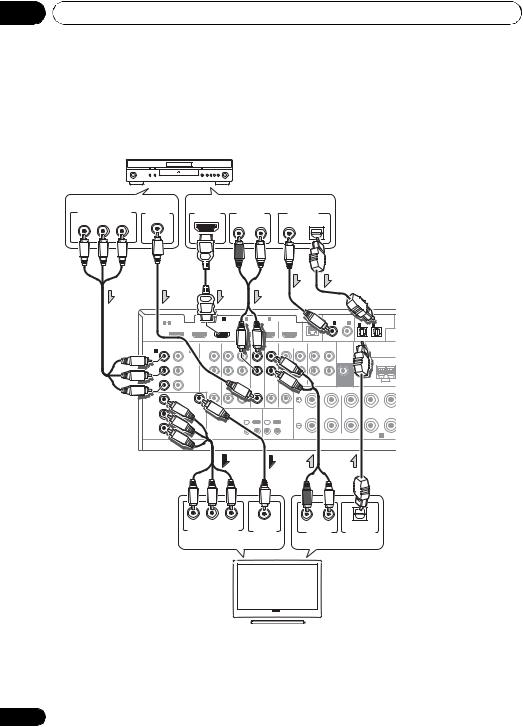
03 Connecting your equipment
Connecting your TV with no HDMI input
This diagram shows connections of a TV (with no HDMI input) and DVD player (or other playback component) to the receiver.
•With these connections, the picture is not output to the TV even if the DVD player is connected with an HDMI cable. Connect the DVD player’s video signals using a composite or component cord.
|
|
|
|
DVD player etc. |
||
|
Select one |
|
|
Select one |
||
COMPONENT VIDEO OUT |
VIDEO OUT |
HDMI OUT |
AUDIO OUT |
DIGITAL OUT |
||
PR |
PB |
Y |
|
R |
ANALOG L |
COAXIAL OPTICAL |
|
|
|
|
|||
HDMI |
BD IN |
IN 1 |
IN 2 |
IN 3 |
IN 4 |
OUT |
LAN |
COAXIAL ASSIGNABLE |
|
OPTICAL |
|
ASSIGNABLE 1 |
4 |
|
|
|
|
|
(10/100) |
IN 1 |
IN 2 |
IN 1 |
ASSIGNABLE |
|
|
|
|
|
|
|
|
|
|
IN 2 |
|
|
|
|
|
|
|
|
|
|
|
|
(OUTPU |
|
|
|
|
|
|
|
|
(DVD) |
(CD) |
(TV/SAT) |
(DVR/BDR) |
COMPONENT VIDEO |
|
AUDIO |
|
|
|
|
PRE OUT |
|
|
||
ASSIGNABLE |
IN 2 |
|
|
|
|
|
|
||||
IN 1 |
|
|
|
|
|
|
|
|
|
|
|
(DVD) |
|
(DVR/BDR) |
L |
|
|
|
|
|
|
|
|
Y |
|
Y |
|
|
|
|
|
|
|
|
|
|
|
|
|
|
|
|
|
|
|
||
 ANTENNA
ANTENNA
PB |
PB |
R |
|
|
|
|
|
|
|
|
|
|
|
ZONE 2 |
DVR/BDR |
DVD |
TV/SAT |
VIDEO |
CD |
CD-R/TAPE |
SUBWOOFER |
|
|
PR |
PR |
OUT |
OUT |
IN |
IN |
IN |
IN |
IN |
OUT IN |
|
AM LOOP |
|
|
|
|
|
|
|
FRONT |
CENTER |
SURROUND |
||
|
|
|
|
|
|
|
|
|
|||
|
MONITOR |
|
|
|
|
|
|
|
R |
L |
R |
|
|
|
|
|
|
|
|
|
|
|
|
Y |
OUT |
|
|
|
|
|
|
|
|
|
|
|
VIDEO |
|
|
|
|
|
|
|
|
|
|
PB |
|
|
|
|
IR |
CONTROL |
|
|
|
|
|
|
|
|
|
|
|
|
|
|
|||
|
|
|
|
IN |
OUT |
IN OUT |
|
|
|
|
|
PR |
|
|
|
|
|
|
|
|
|
|
|
SPEAKERS A
PR |
PB |
Y |
|
R ANALOG L |
OPTICAL |
COMPONENT VIDEO IN |
VIDEO IN |
AUDIO OUT |
DIGITAL OUT |
||
|
Select one |
|
Select one |
||
This connection is  required in order to
required in order to
listen to the sound of the TV over the receiver.
 TV
TV
•Connect using an HDMI cable to listen to HD audio on the receiver. Do not use an HDMI cable to input video signals.
Depending on the video component, it may not be possible to output signals connected by HDMI and other methods simultaneously, and it may be necessary to make output settings.
Please refer to the operating instructions supplied with your component for more information.
26
En
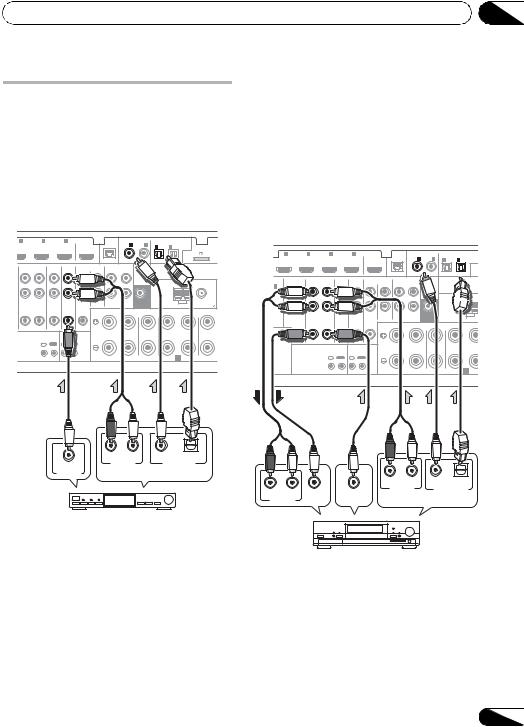
Connecting your equipment
Connecting a satellite/cable receiver or other set-top box
Satellite and cable receivers, and terrestrial digital TV tuners are all examples of so-called ‘set-top boxes’.
When you set up the receiver you’ll need to tell the receiver which input you connected the settop box to (see The Input Setup menu on
page 40).
N 2 |
IN 3 |
IN 4 |
OUT |
LAN |
COAXIAL ASSIGNABLE |
|
|
OPTICAL |
|
|
|
|
|
|
(10/100) |
IN 1 |
IN 2 |
IN 1 |
IN 2 |
ASSIGNABLE |
|
|
|
|
|
|
|
|
ADAPTER POR |
|||
|
|
|
|
|
|
|
|
|
(OUTPUT 5 V |
100 mA MA |
|
|
|
|
|
(DVD) |
(CD) |
(TV/SAT) |
(DVR/BDR) |
|
|
PRE OUT
|
|
|
|
|
|
|
ANTENNA |
|
|
DVR/BDR |
DVD |
TV/SAT |
VIDEO |
CD |
CD-R/TAPE |
SUBWOOFER |
|
|
|
OUT |
IN |
IN |
IN |
IN |
IN |
OUT IN |
|
AM LOOP |
FM UNBAL 75 |
|
|
|
|
|
|
FRONT |
CENTER |
SURROUND |
SURROU |
|
|
|
|
|
|
R |
L |
R |
L R |
IR CONTROL
IN OUT IN OUT
SPEAKERS A
|
R ANALOG L |
COAXIAL OPTICAL |
|
AUDIO OUT |
DIGITAL OUT |
VIDEO OUT |
Select one |
|
STB
03
|
|
|
|
|
Connecting a HDD/DVD recorder, |
English |
|||
VCR and other video sources |
||||
|
||||
This receiver has two sets of audio/video inputs |
|
|||
and outputs suitable for connecting analog or |
|
|||
|
||||
digital video devices, including HDD/DVD |
|
|
||
|
Deutsch |
|||
recorders and VCRs. |
|
|||
|
|
|||
When you set up the receiver you’ll need to tell |
|
|
||
the receiver which input you connected the |
|
|
||
recorder to (see also The Input Setup menu on |
|
|
||
page 40). |
|
|||
IN 1 |
IN 2 |
IN 3 |
IN 4 |
OUT |
LAN |
COAXIAL ASSIGNABLE |
|
OPTICAL |
Français |
|
|
|
|
|
|
(10/100) |
IN 1 |
IN 2 |
IN 1 |
ASSIGNABLE |
|
|
|
|
|
|
|
|
|
IN 2 |
||
|
|
|
|
|
|
|
|
|
(OUTP |
|
|
|
|
|
|
|
(DVD |
|
(TV/SAT) |
(DVR/BDR) |
|
2 |
AUDIO |
|
|
|
|
|
|
|
|
|
Y |
|
|
|
|
|
|
|
|
|
|
ANTENNA 


B |
|
|
|
|
|
|
|
|
|
Italiano |
ZONE 2 |
DVR/BDR |
IR |
CONTROL |
CD |
CD-R/TAPE |
SUBWOOFER |
|
|||
DVD |
TV/SAT |
VIDEO |
|
|
||||||
OUT |
OUT IN |
IN |
IN |
IN |
IN |
OUT |
IN |
|
AM LOOP |
|
R |
|
|
|
|
|
FRONT |
CENTER |
SURROUND |
|
|
R |
|
|
|
|
R |
|
L |
R |
|
|
|
|
|
|
|
|
|
|
|
|
|
DEO |
|
|
|
|
|
|
|
|
|
|
|
IN |
OUT |
IN OUT |
|
|
|
|
|
|
|
|
|
|
|
|
|
|
|
SPEAKERS A |
|
|
|
|
|
|
|
|
|
|
|
|
Nederlands |
|
|
|
|
|
R |
ANALOG |
L |
COAXIAL |
OPTICAL |
Español |
|
|
|
|
|
|
|||||
R ANALOG L |
|
|
|
|
|
AUDIO OUT |
DIGITAL OUT |
|
||
|
|
|
|
|
Select one |
|
||||
AUDIO IN |
VIDEO IN |
VIDEO OUT |
|
|
|
|||||
HDD/DVD recorder, VCR, etc.
•In order to record, you must connect the analog audio cables (the digital connection is for playback only).
27
En
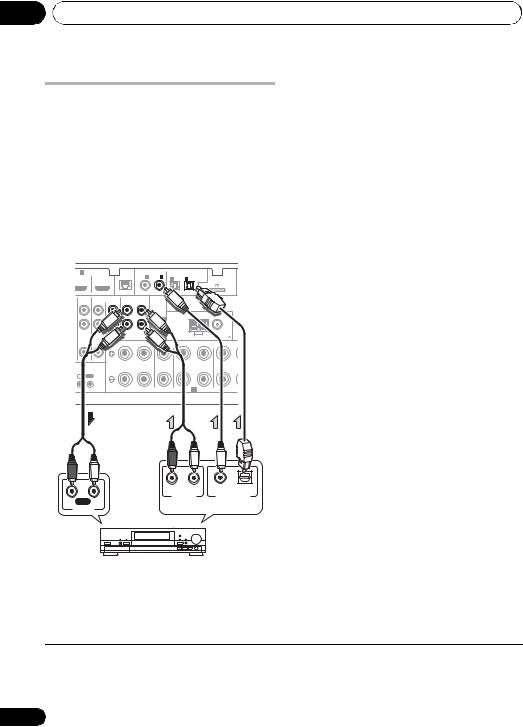
03 Connecting your equipment
Connecting other audio components
This receiver has both digital and analog inputs, allowing you to connect audio components for playback.
One of these inputs have corresponding outputs for use with analog audio recorders.
When you set up the receiver you’ll need to tell the receiver which input you connected the component to (see also The Input Setup menu on page 40).
IN 4 |
OUT |
LAN |
COAXIAL ASSIGNABLE |
|
OPTICAL |
|
|
|
|
|
(10/100) |
IN 1 |
IN 2 |
IN 1 |
ASSIGNABLE |
ADAPTER PORT |
|
|
|
|
|
|
IN 2 |
|||
|
|
|
|
|
|
(OUTPUT 5 V |
100 mA MAX) |
|
|
|
|
(DVD) |
(CD |
|
|
|
|
|
|
|
PRE OUT |
|
|
|
|
|
|
|
|
|
|
ANTENNA |
|
|
|
TV/SAT |
CD-R/TAPE |
|
|
|
|
|
||
IN |
|
OUT |
IN |
|
|
AM LOOP |
FM UNBAL 75 |
|
|
|
FRONT |
|
R |
SURROUND |
L |
SURROUND |
|
|
|
|
|
|
|
R |
||
CONTROL |
|
|
|
|
|
|
|
|
IN |
OUT |
|
|
|
|
|
|
|
|
|
|
|
|
SPEAKERS A |
|
|
|
•If your turntable has line-level outputs (i.e., it has a built-in phono pre-amp), connect it to the CD inputs instead.
•If you’re connecting a recorder, connect the analog audio outputs to the analog audio inputs on the recorder.
About the WMA9 Pro decoder
This unit has an on-board Windows Media™ Audio 9 Professional1 (WMA9 Pro) decoder, so it is possible to playback WMA9 Pro-encoded audio using HDMI, coaxial or optical digital connection when connected to a WMA9 Procompatible player. However, the connected DVD player, set-top box, etc. must be able to output WMA9 Pro format audio signals through a coaxial or optical digital output.
|
|
R ANALOG L |
COAXIAL OPTICAL |
R REC |
|
AUDIO OUT |
DIGITAL OUT |
L |
Select one |
||
AUDIO IN |
|
||
CD-R, MD, DAT, etc.
 Note
Note
1• Windows Media and the Windows logo are trademarks or registered trademarks of Microsoft Corporation in the United States and/or other countries.
• With WMA9 Pro, sound problems may occur depending on your computer system. Note that WMA9 Pro 96 kHz sources will be downsampled to 48 kHz.
28
En
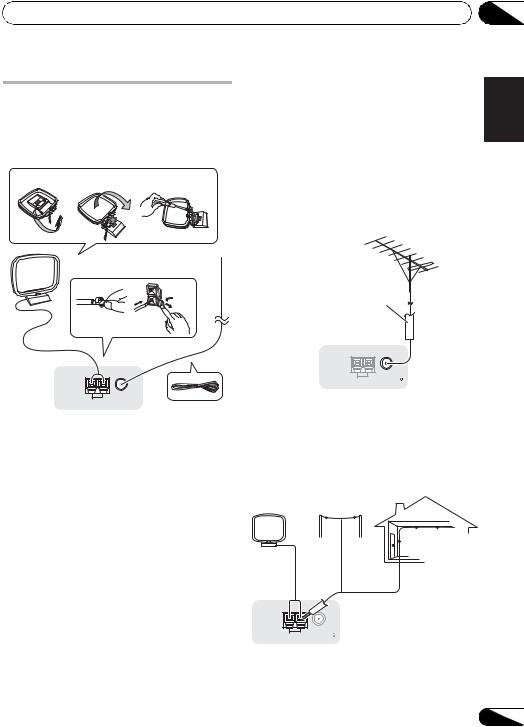
Connecting your equipment
Connecting AM/FM antennas
Connect the AM loop antenna and the FM wire antenna as shown below. To improve reception and sound quality, connect external antennas (see Connecting external antennas below).
fig. a |
fig. b |
fig. c |
3 |
|
1 |
2 |
4
5
ANTENNA
AM LOOP FM UNBAL 75
1Pull off the protective shields of both AM antenna wires.
2Push open the tabs, then insert one wire fully into each terminal, then release the tabs to secure the AM antenna wires.
3Fix the AM loop antenna to the attached stand.
To fix the stand to the antenna, bend in the direction indicated by the arrow (fig. a) then clip the loop onto the stand (fig. b).
•If you plan to mount the AM antenna to a wall or other surface, secure the stand with screws (fig. c) before clipping the loop to the stand. Make sure the reception is clear.
03
4 Place the AM antenna on a flat surface |
English |
||
and in a direction giving the best reception. |
|||
|
|||
5 Connect the FM wire antenna into the FM |
|
||
antenna socket. |
|
||
For best results, extend the FM antenna fully |
|
||
and fix to a wall or door frame. Don’t drape |
Deutsch |
||
loosely or leave coiled up. |
|||
Connecting external antennas |
|||
To improve FM reception connect an external |
|||
FM antenna to the FM UNBAL 75 Ω. |
|
||
|
|
Français |
|
|
75 Ω coaxial cable |
|
|
|
ANTENNA |
Italiano |
|
|
AM LOOP FM UNBAL 75 |
Nederlands |
|
To improve AM reception, connect a 5 m to 6 m |
|||
|
|||
(16 ft. to 20 ft.) length of vinyl-coated wire to the |
|
||
AM LOOP terminals without disconnecting |
|
||
the supplied AM loop antenna. |
|
||
For the best possible reception, suspend |
Español |
||
|
antenna |
||
horizontally outdoors. |
|
||
|
Outdoor |
|
|
|
Indoor antenna |
|
|
|
(vinyl-coated wire) |
|
|
|
5 m to 6 m |
|
|
ANTENNA |
(16 ft. to 20 ft.) |
|
|
AM LOOP |
FM UNBAL 75 |
|
|
29
En
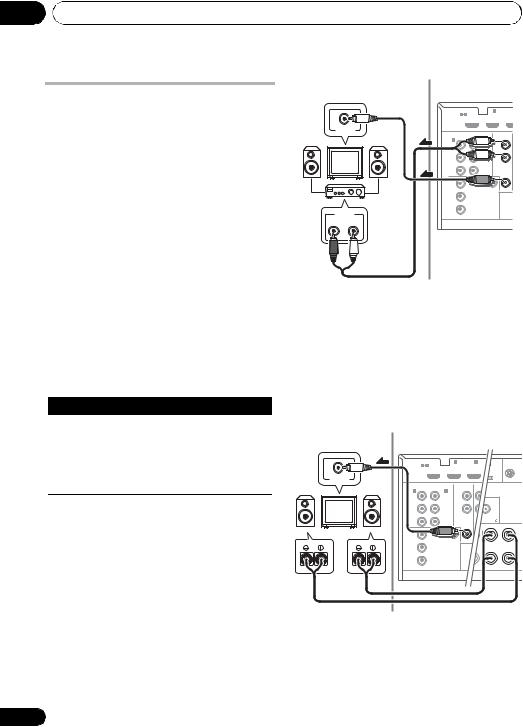
03 Connecting your equipment
MULTI-ZONE setup
This receiver can power up to two independent systems in separate rooms after you have made the proper MULTI-ZONE connections.
Different sources can be playing in two zones at the same time or, depending on your needs, the same source can also be used. The main and sub zone have independent power (the main zone power can be off while sub zone is on) and the sub zone can be controlled by the remote or front panel controls.
Making MULTI-ZONE connections
It is possible to make these connections if you have a separate TV and speakers for the sub zone (ZONE 2). You will also need a separate amplifier if you are not using the MULTI-ZONE setup using speaker terminals (ZONE 2) below for the sub zone.
MULTI-ZONE listening options
The following table shows the signals that can be output to ZONE 2:
Sub Zone Input functions available
ZONE 2 DVD, TV/SAT, DVR/BDR, VIDEO, INTERNET RADIO, iPod/USB, CD, CD- R/TAPE, TUNER, ADAPTER PORT, SIRIUS
(Outputs analog audio and composite video.)
Basic MULTI-ZONE setup (ZONE 2)
• Connect a separate amplifier to the AUDIO ZONE 2 OUT jacks and a TV monitor to the VIDEO ZONE 2 OUT jack, both on this receiver.
You should have a pair of speakers attached to the sub zone amplifier as shown in the following illustration.
Sub zone Main zone |
|
|
HDMI |
BD IN IN 1 |
IN |
ASSIGNABLE 1 |
4 |
|
VIDEO IN |
|
|
COMPONENT |
AUDIO |
|
IN 1 |
|
|
|
|
|
(DVD) |
|
|
Y |
|
|
PB |
|
|
|
|
ZONE 2 |
PR |
PR |
OUT |
|
||
Y |
|
|
|
VIDEO |
|
PB |
|
|
PR |
|
|
AUDIO IN
R L
MULTI-ZONE setup using speaker terminals (ZONE 2)
You must select ZONE 2 in Speaker system setting on page 100 to use this setup.
• Connect a TV monitor to the VIDEO ZONE 2 OUT jacks on this receiver.
You should have a pair of speakers attached to the surround back speaker terminals as shown below.
Sub zone Main zone
VIDEO IN
L R
HDMI |
BD IN |
IN 1 |
ALIN 2 |
SIRIU |
|
ASSIGNABLE 1 |
4 |
|
BLE |
ADAPTER PORT |
|
|
|
|
|
IN |
|
|
|
|
UTPUT 5 V 500 mA MAX) |
|
|
COMPONENT VIDEO |
|
AUDIO |
|
|
|
ASSIGNABLE |
IN 2 |
|
|
||
IN 1 |
|
|
|
|
|
(DVD) |
|
(DVR/BDR) |
L |
|
|
Y |
|
Y |
|
|
|
PB |
|
PB |
R |
|
|
|
|
|
ZONE 2 |
DV |
|
PR |
|
PR |
OUT OP |
OUTFM UNBAL 75 |
|
D |
R |
SURROUND BACK |
L |
L(Single) |
|
Y |
|
|
VIDEO |
|
|
PB |
|
|
PR
30
En
